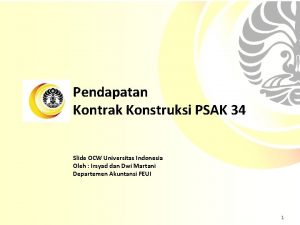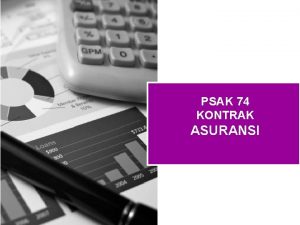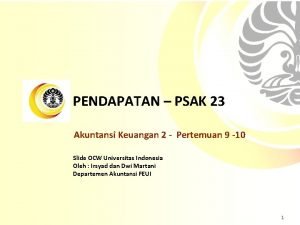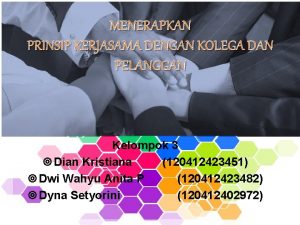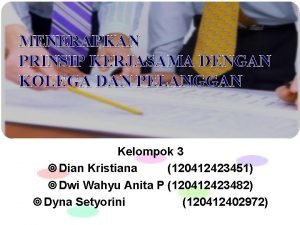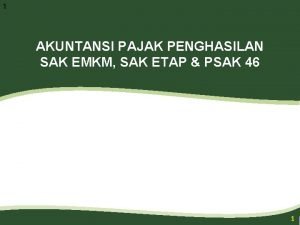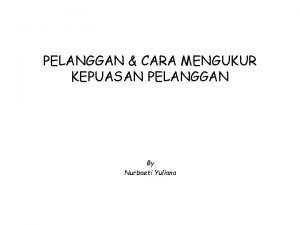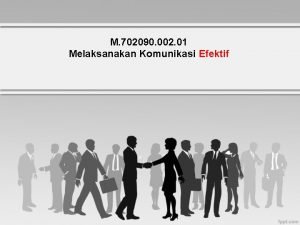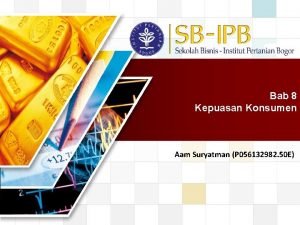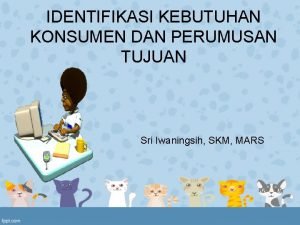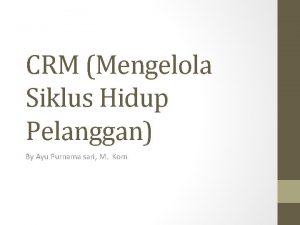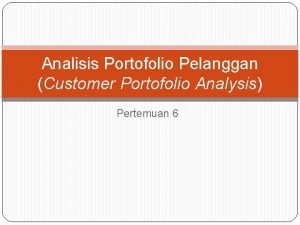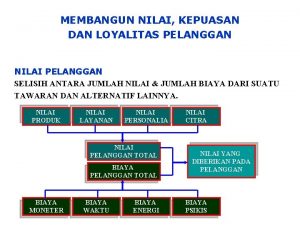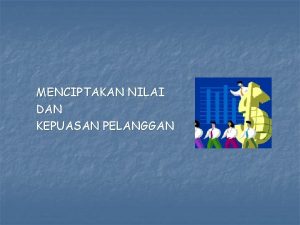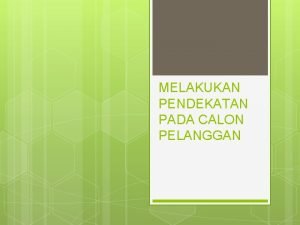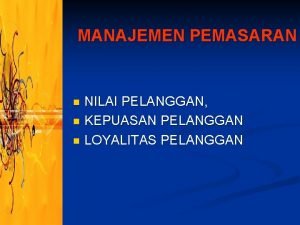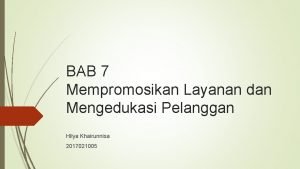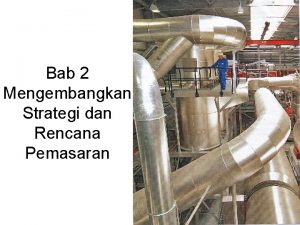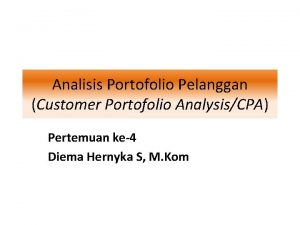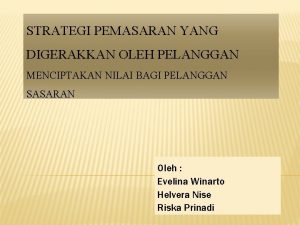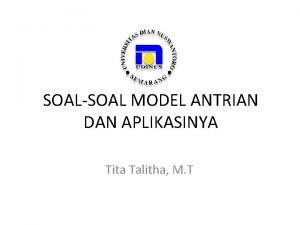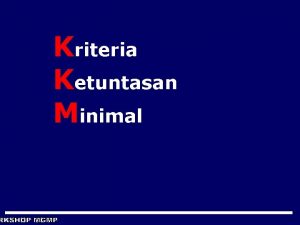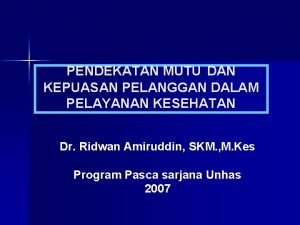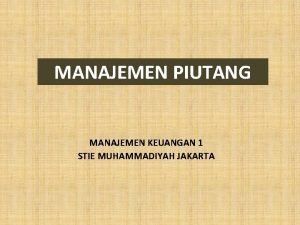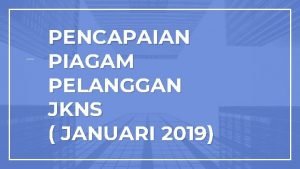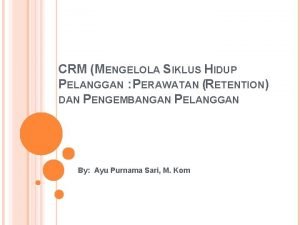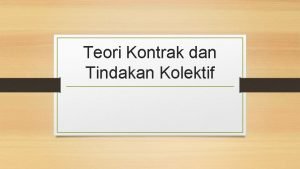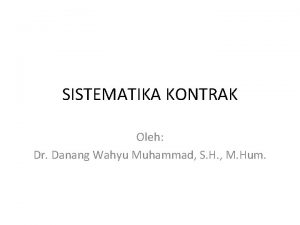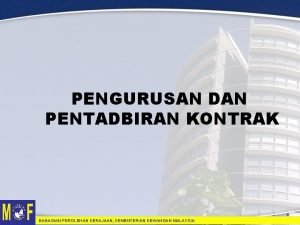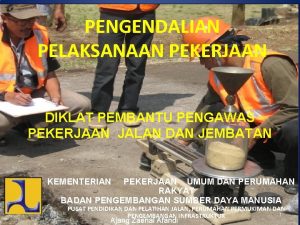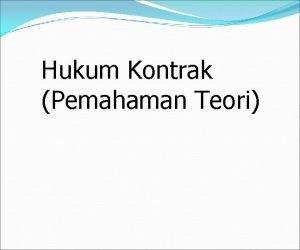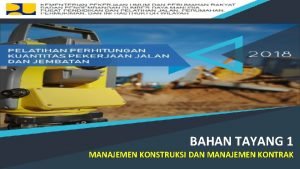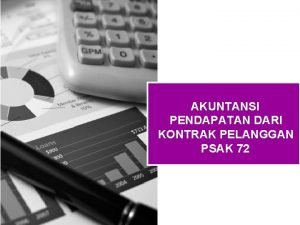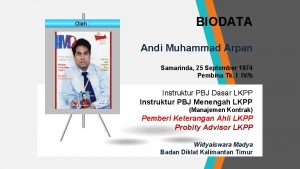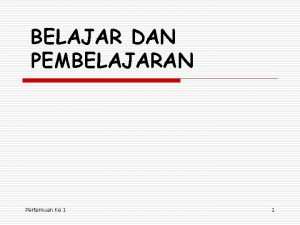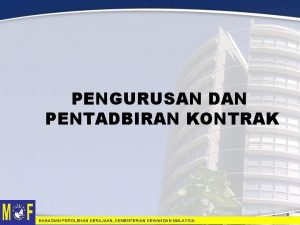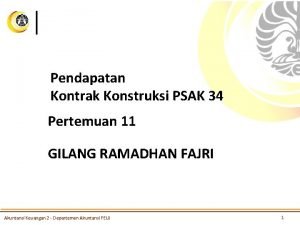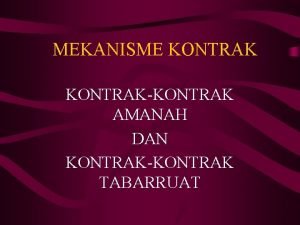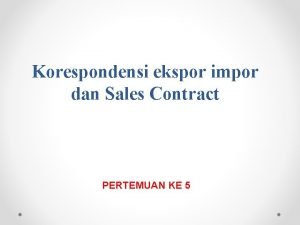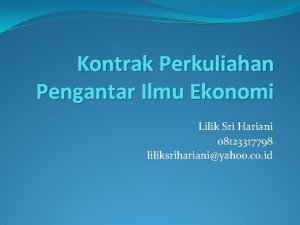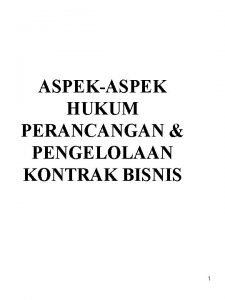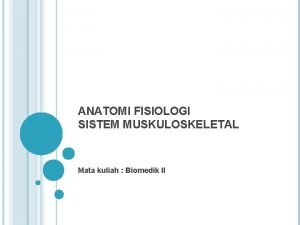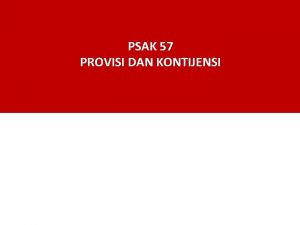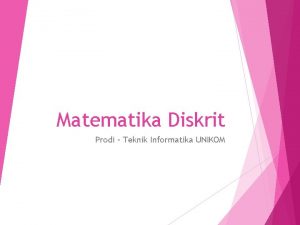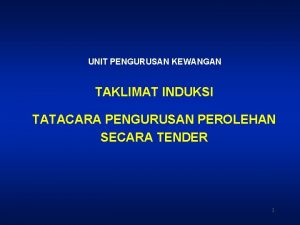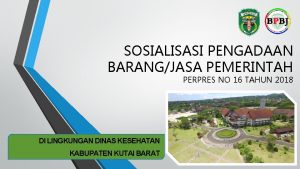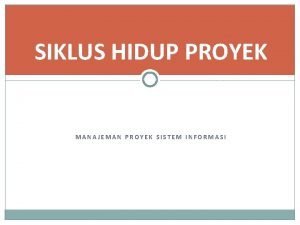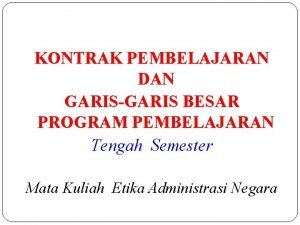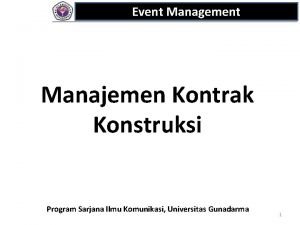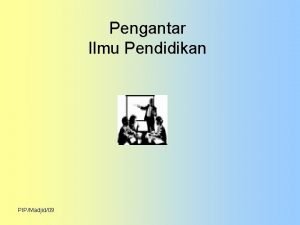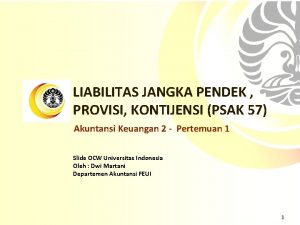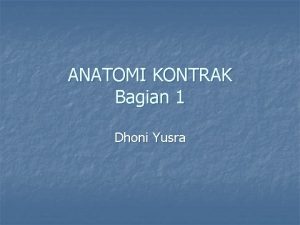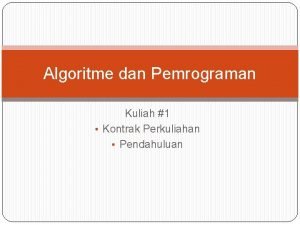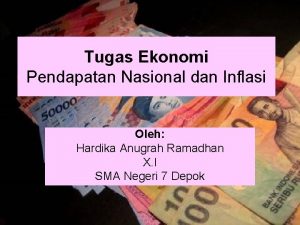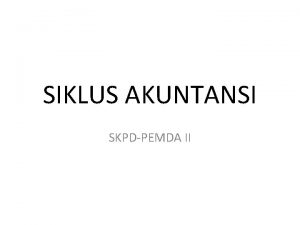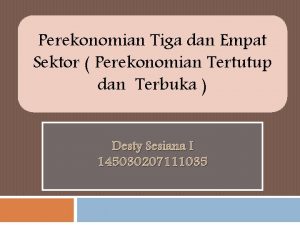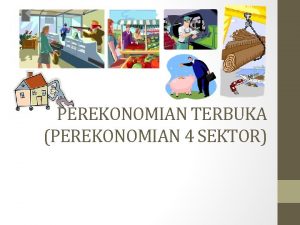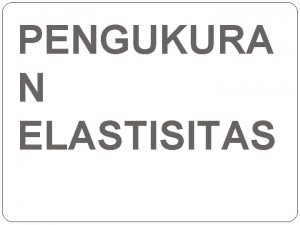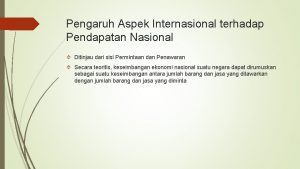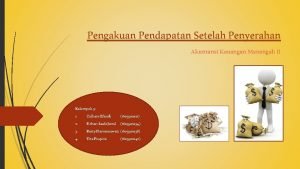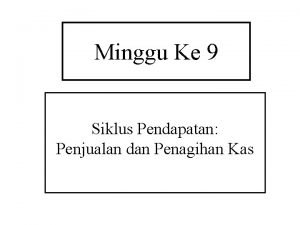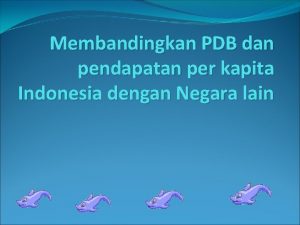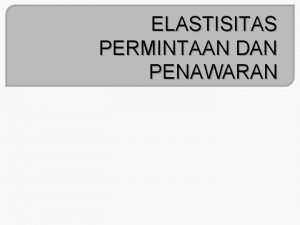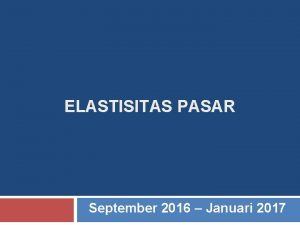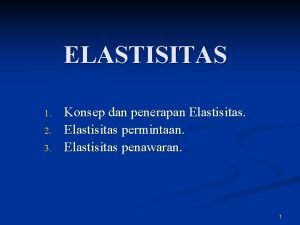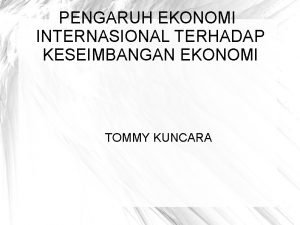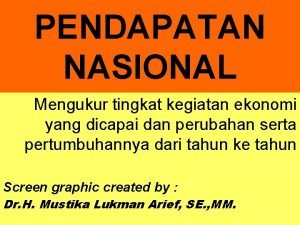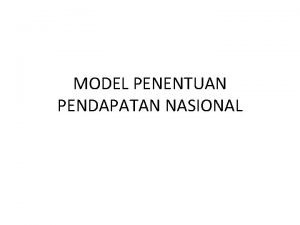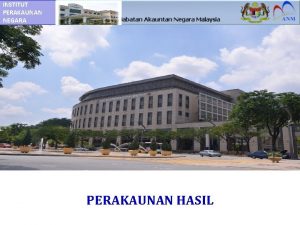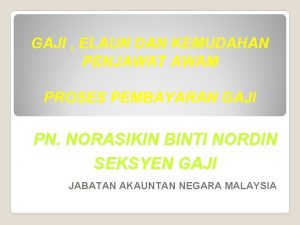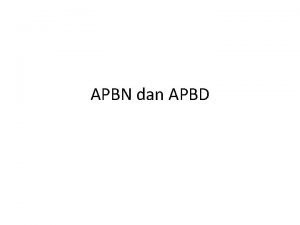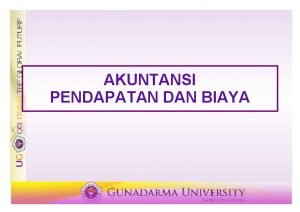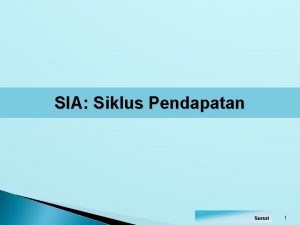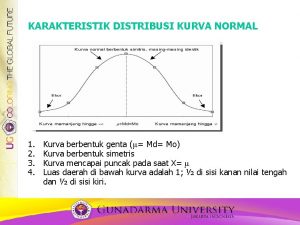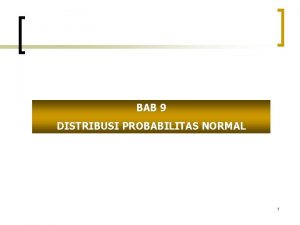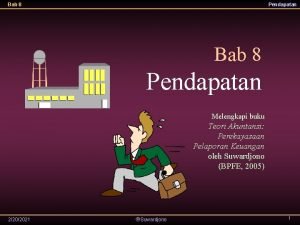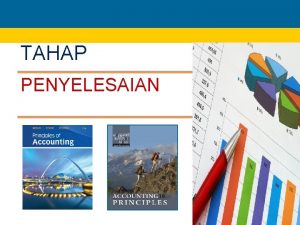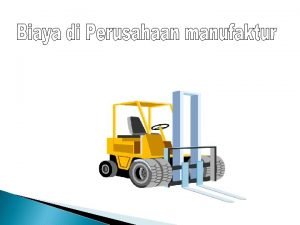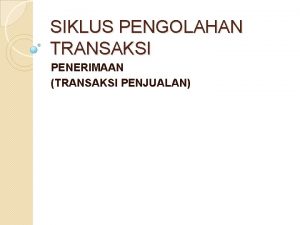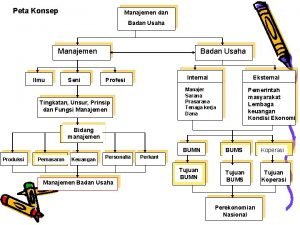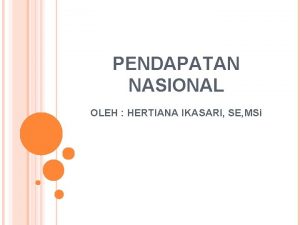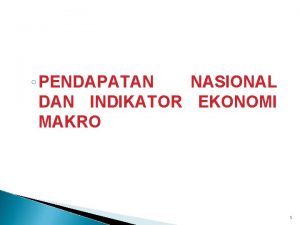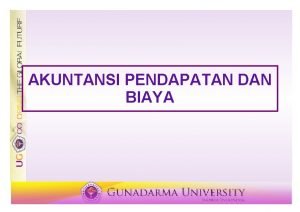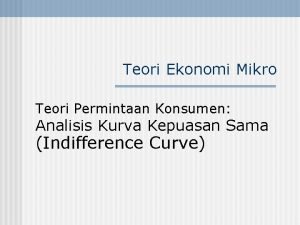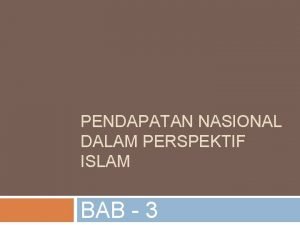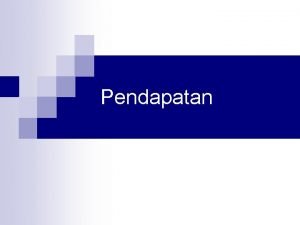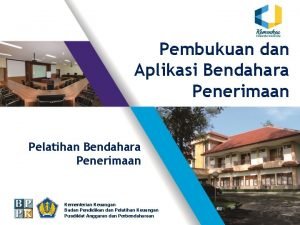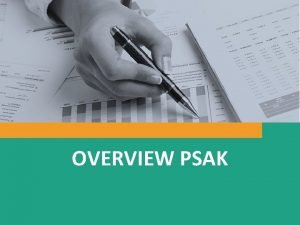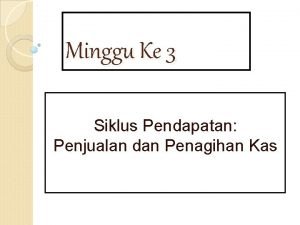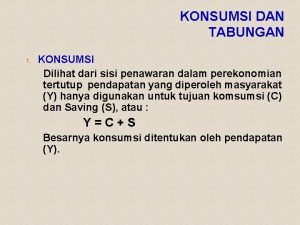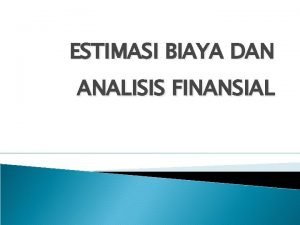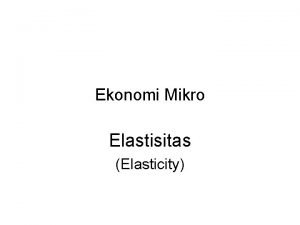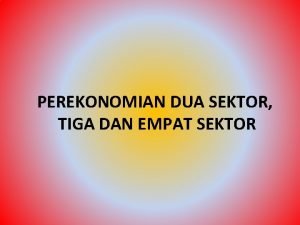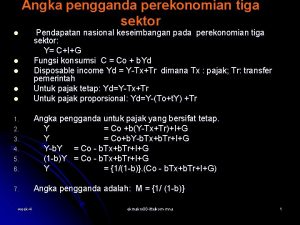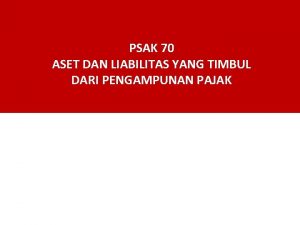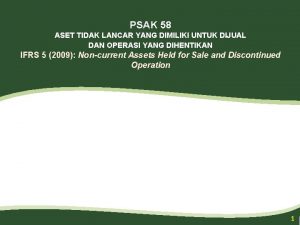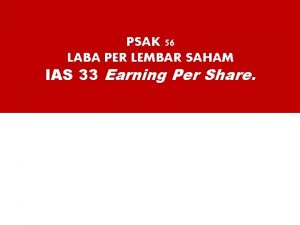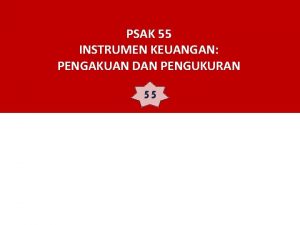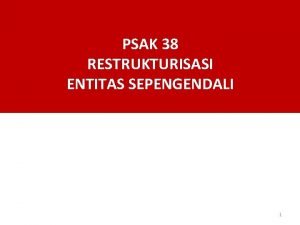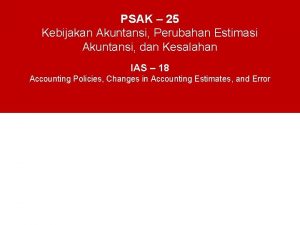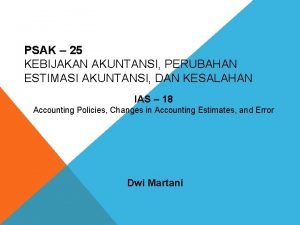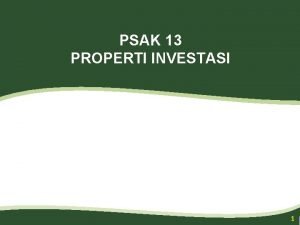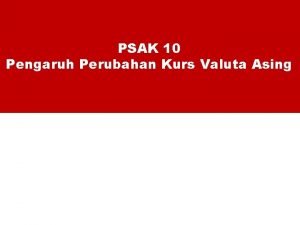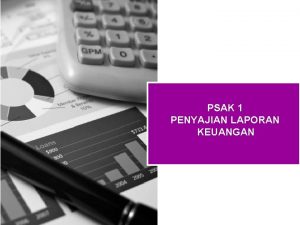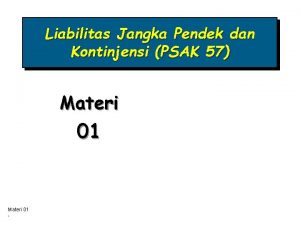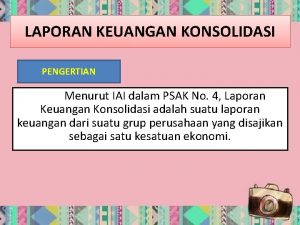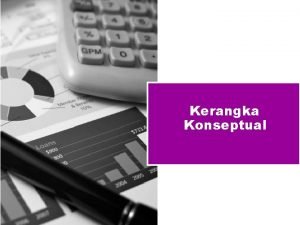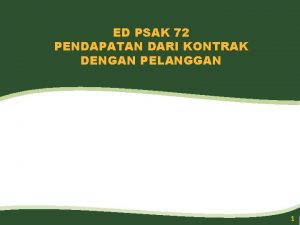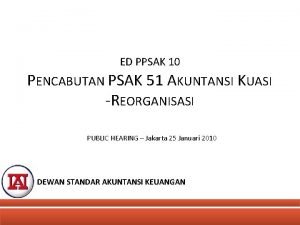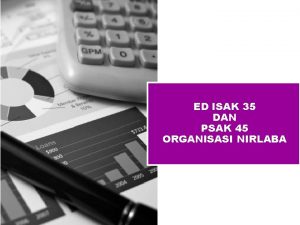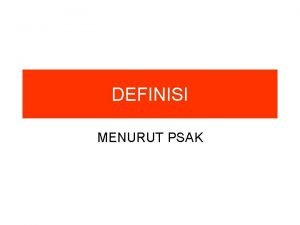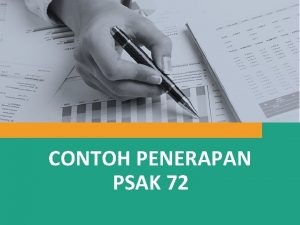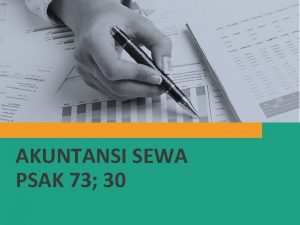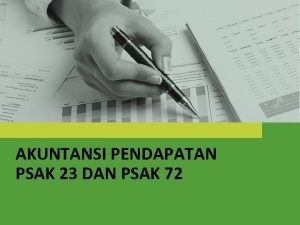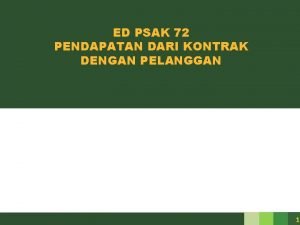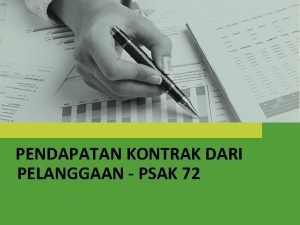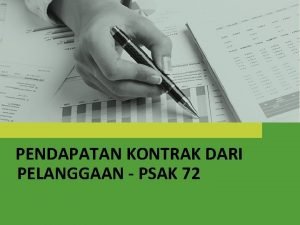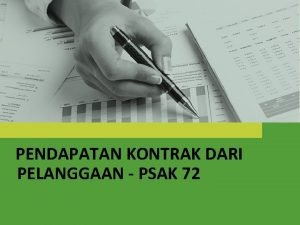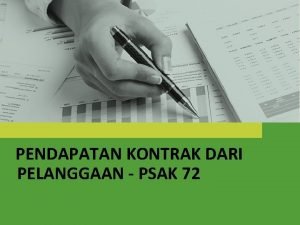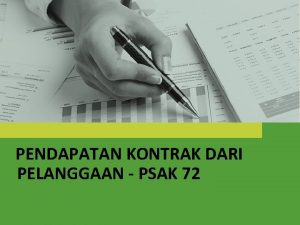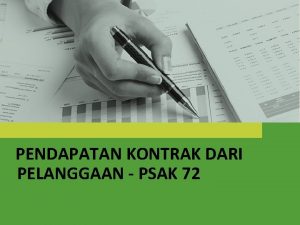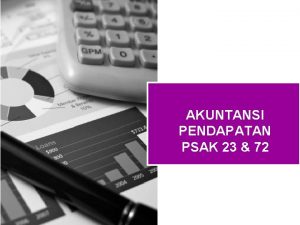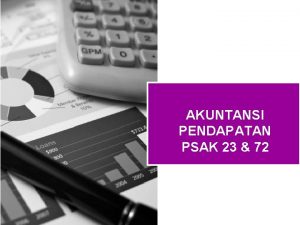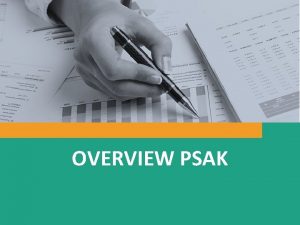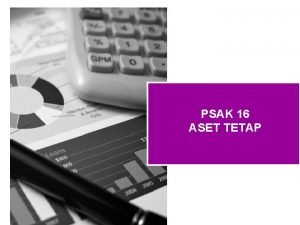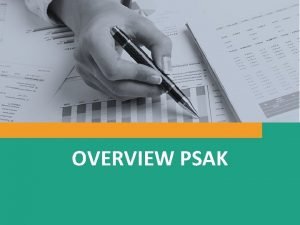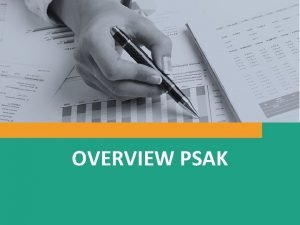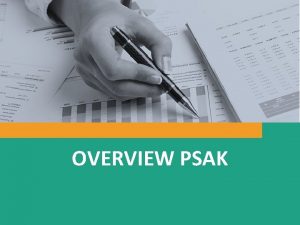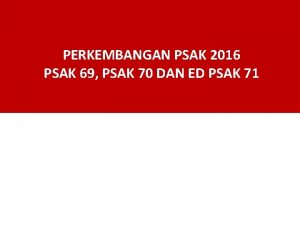ED PSAK 72 PENDAPATAN DARI KONTRAK DENGAN PELANGGAN








































































































































































- Slides: 168

ED PSAK 72 PENDAPATAN DARI KONTRAK DENGAN PELANGGAN 1

2 Agenda 1. Pokok-Pokok Perubahan PSAK 72 2. Isi Standar 3. Ilustrasi 4. Diskusi 2

3 PSAK 72 • PSAK 72 merupakan adopsi IFRS 15 Revenue from contracts with customers effective 2018, kecuali: – Item terkait IFRS 16 Leases (karena belum diadopsi) hak penggunaan aset – Tanggal efektif dan penarikan standar yang telah ada • Standar ini bersifat principles based • Standar komprehensif karena mengatur semua jenis Pendapatan yang terkait dengan kontrak pelanggan sehingga menghilangkan pengaturan dalam standar yang lain. 3

4 PSAK yang Digantikan PSAK 23: Pendapatan PSAK 34: Kontrak Konstruksi, ISAK 10: Program Loyalitas Pelanggan, ISAK 21: Perjanjian Konstruksi Real Estat, ISAK 27: Pengalihan Aset dari Pelanggan, dan PSAK 44: Akuntansi Aktivitas Pengembangan Real Estate. 4

5 PSAK 72 Standar Lampiran A - Daftar Istilah Lampiran B – Pedoman Penerapan Lampiran C – Tanggal Efektif dan Ketentuan Transasi Contoh Ilustratif Lampiran D – Penyesuaian terhadap Pernyataan Lain 5

6 PSAK 72 Pendahuluan • tujuan dan ruang lingkup Pengakuan • Identifikasi kontrak, kombinasi kontrak, modifikasi kontrak, identifikasi dan penyelesaian kewajiban Pengukuran • Menentukan, mengalokasikan harga transaksi, perubahan Biaya Kontrak • Biaya incremental, pemenuhan kontrak, amortisasi dan penurunan nilai Penyajian Pengungkapan 6

7 Tahapan dalam Pengakuan Mengidentifikasi kontrak dengan pelanggan ; Mengindentifikasi kewajiban pelaksanaan; Menentukan harga transaksi; Mengalokasikan harga transaksi terhadap kewajiban pelaksanaan; Mengakui pendapatan ketika (pada saat) entitas telah menyelesaikan kewajiban pelaksanaan. 7

8 Tujuan • Menetapkan prinsip tentang sifat, jumlah, waktu, dan ketidakpastian pendapatan dan arus kas yang timbul dari kontrak dengan pelanggan. • Pencapaian tujuan – Mengakui pendapatan untuk menggambarkan pengalihan barang atau jasa yang dijanjikan kepada pelanggan – Mempertimbangkan syarat kontrak serta seluruh fakta dan keadaan yang relevan – Untuk kontrak individual dan portfolio kontrak 8

9 Ruang Lingkup • Untuk seluruh kontrak dengan pelanggan, kecuali: a) kontrak sewa - PSAK 30 Sewa; b) kontrak asuransi - PSAK 62 Kontrak Asuransi; c) instrumen keuangan - ED PSAK 71: Instrumen Keuangan, PSAK 65: Laporan Keuangan Konsolidasian, PSAK 66: Pengaturan Bersama, PSAK 4: Laporan Keuangan Tersendiri dan PSAK 15 Investasi pada Entitas Asosiasi dan Ventura Bersama; dan d) Pertukaran nonmoneter antara entitas dalam lini bisnis yang sama untuk memfasilitasi penjualan kepada pelanggan atau pelanggan potensial kontrak antara dua perusahaan minyak untuk menukarkan minyak untuk memenuhi permintaan dari pelanggan dalam lokasi yang berbeda secara tepat waktu. 9

1 0 Pengakuan Indentifikasi kontrak Kombinasi kontrak Modifikasi kontrak Identifikasi kewajiban pelaksanaan Penyelesaian kewajiban pelaksanaan 10

1 1 Mengidentifikan Kontrak Entitas mencatat kontrak dgn pelanggan hanya jika seluruh kriteria berikut terpenuhi: a) para pihak dalam kontrak telah menyetujui kontrak (secara tertulis, lisan atau sesuai dengan praktik bisnis pada umumnya) dan berkomitmen untuk melaksanakan kewajiban mereka masing-masing; b) entitas dapat mengidentifikasi hak setiap pihak mengenai barang atau jasa yang akan dialihkan; c) entitas dapat mengidentifikasi jangka waktu pembayaran barang atau jasa yang akan dialihkan; d) kontrak memiliki substansi komersial (yaitu risiko, waktu, atau jumlah arus kas masa depan entitas diperkirakan berubah sebagai akibat dari kontrak); dan e) kemungkinan besar entitas akan menagih imbalan yang akan menjadi haknya dalam pertukaran barang atau jasa yang akan dialihkan ke pelanggan. Entitas hanya mempertimbangkan kemampuan dan intensi pelanggan untuk membayar jumlah imbalan ketika jatuh tempo. Jumlah imbalan yang akan menjadi hak entitas mungkin lebih kecil dari jumlah yang tercatat dalam kontrak jika imbalan bersifat variabel karena entitas dapat menawarkan suatu konsesi harga kepada pelanggan (lihat paragraf 52). 11

1 2 Kombinasi Kontrak • Entitas mengombinasikan dua atau lebih kontrak yang disepakati dan mencatat kontrak tersebut sebagai kontrak tunggal jika satu atau lebih kriteria berikut terpenuhi: a. b. c. kontrak dinegosiasikan sebagai satu paket dengan tujuan komersial tunggal; jumlah imbalan yang dibayarkan dalam satu kontrak bergantung pada harga atau pelaksanaan dari kontrak lain; atau barang atau jasa yang dijanjikan dalam kontrak (atau beberapa barang atau jasa yang dijanjikan dalam setiap kontrak) merupakan kewajiban pelaksanaan tunggal sesuai dengan paragraf 22 -30. 12

Modifikasi Kontrak • Modifikasi kontrak adalah perubahan dalam ruang lingkup atau harga kontrak (atau keduanya) yang disetujui oleh para pihak dalam kontrak. • Entitas mencatat sebagai kontrak terpisah jika kondisi berikut terpenuhi: – ruang lingkup kontrak meningkat karena penambahan barang atau jasa yang dijanjikan bersifat dapat dibedakan (distinct) (sesuai dengan paragraf 26 -30); dan – harga kontrak meningkat oleh sejumlah imbalan yang mencerminkan harga jual berdiri sendiri (stand-alone selling prices) entitas atas penambahan barang atau jasa yang dijanjikan dan penyesuaian yang tepat terhadap harga yang mencerminkan keadaan kontrak tertentu. 13

Modifikasi Kontrak • Jika modifikasi kontrak tidak dicatat sebagai kontrak terpisah, maka entitas mencatat barang atau jasa yang dijanjikan yang belum dialihkan pada tanggal modifikasi kontrak dengan cara manapun di bawah ini yang dapat diterapkan: – Entitas mencatat modifikasi kontrak seolah-olah modifikasi kontrak tersebut merupakan penghentian kontrak yang ada dan menciptakan kontrak baru, jika sisa barang atau jasa bersifat dapat dibedakan dari barang atau jasa yang dialihkan pada atau sebelum tanggal modifikasi kontrak. Jumlah imbalan yang dialokasikan pada sisa kewajiban pelaksanaan (atau pada sisa barang atau jasa yang bersifat dapat dibedakan dalam kewajiban pelaksanaan tunggal yang diidentifikasikan sesuai dengan paragraf 22(b)) adalah jumlah dari: • (i) imbalan yang dijanjikan oleh pelanggan (termasuk jumlah yang telah diterima dari pelanggan) yang tercakup dalam estimasi harga transaksi dan yang belum diakui sebagai pendapatan; dan • (ii) imbalan yang dijanjikan sebagai bagian dari modifikasikontrak. 14

1 5 Mengidentifikan Kewajiban Pelaksanaan • Pada awal kontrak, entitas menilai barang atau jasa yang dijanjikan dalam kontrak dengan pelanggan dan mengidentifikasi sebagai kewajiban pelaksanaan setiap janji untuk mengalihkan kepada pelanggan baik: a) suatu barang atau jasa (atau sepaket barang atau jasa) yang bersifat dapat dibedakan; atau b) serangkaian barang atau jasa yang bersifat dapat dibedakan yang secara substansial sama dan memiliki pola pengalihan yang sama kepada pelanggan (lihat paragraf 23). 15

1 6 Mengidentifikasi Kewajiban Pelaksanaan Janji kontrak dengan pelanggan • Kontrak umumnya secara eksplisit menyatakan barang atau jasa yang dijanjikan untuk dialihkan kepada pelanggan. • Akan tetapi, kewajiban pelaksanaan tidak terbatas pada barang atau jasa yang secara eksplisit dinyatakan dalam kontrak. Barang atau jasa Bersifat dapat Dibedakan • • Penjualan barang yang diproduksi; yang dibeli Pelaksanaan tugas Penyediaan jasa; jasa pengaturan Pembaian hak kepada barang dan jasa 16

1 7 Barang atau Jasa Bersifat dapat Dibedakan • Barang atau jasa yang dijanjikan kepada pelanggan bersifat dapat • dibedakan jika kedua kriteria berikut terpenuhi: a. pelanggan memperoleh manfaat dari barang atau jasa baik barang atau jasa itu sendiri atau bersama dengan sumber daya lain yang siap tersedia kepada pelanggan (yaitu barang atau jasa yang bersifat dapat dibedakan); dan b. janji entitas untuk mengalihkan barang atau jasa kepada pelanggan dapat diidentifikasi secara terpisah dari janji lain dalam kontrak (yaitu janji untuk mengalihkan barang atau jasa yang bersifat dapat dibedakan dalam konteks kontrak tersebut). Jika barang atau jasa yang dijanjikan bersifat tidak dapat dibedakan, entitas mengombinasikan barang atau jasa dengan barang atau jasa lain yang dijanjikan sampai entitas mengidentifikasi sepaket barang atau jasa tersebut bersifat dapat dibedakan. 17

1 8 Penyelesaian Kewajiban Pelaksanaan yang Diselesaikan pada Waktu Tertentu Pengukuran Kemajuan terhadap Penyelesaian Kewajiban Pelaksanaan secara penuh • Metode Pengukuran Kemajuan • Pengukuran Kemajuan yang Rasional 18

1 9 Penyelesaian Kewajiban Pelaksanaan • Entitas mengakui pendapatan ketika (atau selama) entitas menyelesaikan kewajiban pelaksanaan dengan mengalihkan barang atau jasa yang dijanjikan (yaitu aset) kepada pelanggan. Aset dialihkan ketika (atau selama) pelanggan memperoleh pengendalian atas aset. • Pada awal kontrak entitas menentukan apakah entitas menyelesaikan kewajiban pelaksanaan sepanjang waktu (sesuai dengan paragraf 35 -37) atau menyelesaikan kewajiban pelaksanaan pada suatu waktu tertentu (sesuai dengan paragraf 38). 19

2 0 Kewajiban Pelaksanaan yang Diselesaikan Sepanjang Waktu (Performance Obligation Over Time) • Entitas mengalihkan pengendalian barang atau jasa sepanjang waktu dan, oleh karena itu, menyelesaikan kewajiban pelaksanaan dan mengakui pendapatan sepanjang waktu, jika satu dari kriteria berikut terpenuhi: a. pelanggan secara simultan menerima dan mengonsumsi manfaat yang disediakan oleh kinerja entitas saat entitas melaksanakan kewajiban pelaksanaannya tersebut (lihat paragraf PP 03 -PP 04); b. kinerja entitas menciptakan atau meningkatkan aset (sebagai contoh, pekerjaan dalam proses) yang dikendalikan pelanggan sebagai aset yang diciptakan atau ditingkatkan (lihat paragraph PP 05); atau c. kinerja entitas tidak menciptakan suatu aset dengan penggunaan alternatif terhadap entitas (lihat paragraf 36) dan entitas memiliki hak yang dapat dipaksakan untuk pembayaran kinerja yang 20

2 1 Kewajiban Pelaksanaan yang Diselesaikan Pada Waktu Tertentu (Performance Obligation At a Point In Time) • Jika kewajiban pelaksanaan tidak diselesaikan sepanjang waktu sesuai dengan paragraf 35 -37, maka entitas menyelesaikan kewajiban pelaksanaan pada waktu tertentu. • Untuk menentukan waktu tertentu dimana pelanggan memperoleh pengendalian atas aset yang dijanjikan dan entitas menyelesaikan kewajiban pelaksanaan, entitas mempertimbangkan persyaratan pengendalian dalam paragraf 31 -34. • Sebagai tambahan, entitas mempertimbangkan indikator pengalihan pengendalian, yang mencakup, tetapi tidak terbatas pada, hal berikut: a. Entitas memiliki hak kini atas pembayaran aset b. Pelanggan memiliki hak kepemilikan legal atas aset c. Entitas telah mengalihkan kepemilikan fisik atas aset d. Pelanggan memiliki risiko dan manfaat signifikan atas kepemilikan aset e. Pelanggan telah menerima aset 21

2 2 Pengukuran Menentukan harga transaksi • • Imbalan Variabel Liabilitas Pengemalian Estimasi Pematasan Imbalan Variabel Penentuan kembali Imbalan Variabel Keberadaan Komponan Pendanaan Signifikan dalam Kontrak Imbalan Non Kas Uang Imbalan kepada Pelanggan Mengalokasikan harga transaksi terhadap kewajiban Pelaksanaan Perubahan dalam Harga Transaksi 22

2 3 Menentukan Harga Transaksi • Ketika (atau selama) kewajiban pelaksanaan diselesaikan, entitas mengakui pendapatan atas sejumlah harga transaksi (yang tidak termasuk estimasi atas imbalan variabel yang dibatasi sesuai dengan paragraf 56 -58) yang dialokasikan terhadap kewajiban pelaksanaan. Menentukan Harga Transaksi • Entitas mempertimbangkan syarat kontrak dan praktik bisnis umum entitas untuk menentukan harga transaksi. Harga transaksi adalah jumlah imbalan yang diperkirakan menjadi hak entitas dalam pertukaran untuk mengalihkan barang atau jasa yang dijanjikan kepada pelanggan, tidak termasuk jumlah yang ditagih atas nama pihak ketiga (sebagai contoh, beberapa pajak penjualan). Imbalan yang dijanjikan dalam kontrak dengan pelanggan dapat mencakup jumlah tetap, jumlah variabel, atau keduanya. 23

2 4 Menentukan Harga Transaksi • Entitas mempertimbangkan syarat kontrak dan praktik bisnis umum entitas untuk menentukan harga transaksi. Sifat, waktu, dan jumlah imbalan yang dijanjikan oleh pelanggan mempengaruhi estimasi harga transaksi. • Ketika menentukan harga transaksi, entitas mempertimbangkan dampak dari seluruh hal berikut: a. imbalan variabel (lihat paragraf 50 -55 dan 59); b. estimasi pembatas imbalan variabel (lihat paragraf 56 -58); c. keberadaan komponen pendanaan signifikan dalam kontrak (lihat paragraf 60 -65); d. imbalan nonkas (lihat paragraf 66 -69); dan e. utang imbalan kepada pelanggan (lihat paragraf 70 -72). 24

2 5 Mengalokasikan Harga Transaksi terhadap Kewajiban Pelaksanaan • Tujuan ketika mengalokasikan harga transaksi adalah entitas mengalokasikan harga transaksi terhadap setiap kewajiban pelaksanaan (atau barang atau jasa bersifat dapat dibedakan) dalam jumlah yang menggambarkan jumlah imbalan yang diharapkan menjadi hak entitas dalam pertukaran untuk mengalihkan barang atau jasa yang dijanjikan kepada pelanggan. • Untuk memenuhi tujuan alokasi, entitas mengalokasikan harga transaksi terhadap setiap kewajiban pelaksanaan yang diidentifikasi dalam kontrak dengan dasar harga jual berdiri sendiri relatif (relative stand-alone selling price) sesuai dengan paragraf 76 -80, kecuali diatur khusus dalam paragraf 81 -83 (untuk alokasi diskon) dan paragraf 84 -86 (untuk alokasi 25

2 6 Biaya Kontrak Biaya inkremantal atas Perolehan Kontrak Biaya Pemenuhan Kontrak Amortisasi dan Penurunan Nilai 26

2 7 Penyajian • Ketika salah satu pihak dalam kontrak telah melaksanakan, entitas menyajikan kontrak dalam laporan posisi keuangan sebagai aset kontrak atau liabilitas kontrak, bergantung pada hubungan antara kinerja entitas dan pembayaran pelanggan. Entitas menyajikan hak tanpa syarat terhadap imbalan secara terpisah sebagai piutang. 27

2 8 Pengungkapan • Tujuan persyaratan pengungkapan adalah agar entitas mengungkapkan informasi yang cukup yang memungkinkan pengguna laporan keuangan memahami sifat, jumlah, waktu dan ketidakpastian pendapatan dan arus kas yang timbul dari kontrak dengan pelanggan. Untuk mencapai tujuan tersebut, entitas mengungkapkan informasi kualitatif dan kuantitatif tentang seluruh hal berikut: a. kontrak dengan pelanggan (lihat paragraf 113 -122); b. pertimbangan signifikan dan perubahan dalam pertimbangan, yang dibuat dalam menerapkan Pernyataan ini terhadap kontrak tersebut (lihat paragraf 123 -126); dan c. aset yang diakui dari biaya untuk memperoleh atau memenuhi kontrak dengan pelanggan sesuai dengan paragraf 91 atau 95 (lihat paragraf 127 -128). 28

2 9 Pengungkapan • Kontrak dengan Pelanggan – – Pemisahan Pendapatan Saldo Kontrak Kewajiban Pelaksanaan Harga Transaksi yang Dialokasikan terhadap Sisa Kewajiban Pelaksanaan • Pertimbangan Signifikan dalam Penerapan Pernyataan Ini – Menentukan Waktu Penyelesaian Kewajiban Pelaksanaan – Menentukan harga transaksi dan jumlah yang dialokasikan untuk kewajiban pelaksanaan • Aset yang Diakui dari Biaya untuk Memperoleh atau Memenuhi Kontrak dengan Pelanggan 29

3 0 Tanggal Efektif • Entitas menerapkan Pernyataan ini untuk periode tahun buku yang dimulai pada atau setelah 1 Januari 2019. Penerapan dini diperkenankan. • Jika entitas menerapkan Pernyataan ini lebih dini, maka entitas mengungkapkan fakta tersebut. 30

3 1 Ketentuan Transisi (Paragraf C 02 -C 08) • Entitas menerapkan Pernyataan ini menggunakan satu dari dua metode berikut: a. secara retrospektif untuk setiap periode pelaporan sajian sebelumnya sesuai dengan PSAK 25: Kebijakan Akuntansi, Perubahan Estimasi Akuntansi, dan Kesalahan tunduk pada panduan (expedients) dalam paragraf C 05; atau b. secara retrospektif dengan dampak kumulatif atas penerapan secara awal Pernyataan ini diakui pada tanggal penerapan awal sesuai dengan paragraf C 07 -C 08. 31

3 2 Pedoman Penerapan a. Pemisahaan Pendapatan b. kewajiban pelaksanaan diselesaikan sepanjang waktu (paragraph PP 2 -PP 13); c. metode untuk mengukur kemajuan terhadap penyelesaian kewajiban pelaksanaan secara penuh (paragraf PP 14 -PP 19); d. penjualan dengan hak retur (paragraf PP 20 -PP 27); e. garansi (paragraf PP 28 -PP 33); f. imbalan prinsipal dibandingkan dengan agen (paragraf PP 34 PP 38); g. opsi pelanggan untuk tambahan barang atau jasa (paragraph PP 39 -PP 43); h. hak pelanggan yang tidak dilaksanakan (paragraf PP 44 -PP 47); 32

3 3 Pedoman Penerapan i. biaya dibayar di muka yang tidak dapat dikembalikan (dan beberapa biaya terkait) (paragraf PP 48 -PP 51); j. lisensi (paragraf PP 52 -PP 63 B); k. perjanjian pembelian kembali (paragraf PP 64 -PP 76) l. pengaturan konsinyasi (paragraf PP 77 -PP 78); m. pengaturan bill-and-hold (paragraf PP 79 -PP 82); n. penerimaan pelanggan (paragraf PP 83 -PP 86); dan o. pengungkapan pemisahan pendapatan (paragraf PP 87 -PP 89). 33

3 4 Pedoman Penerapan a. Pedoman penerapan ini disusun ke dalam kategori berikut: b. (a) kewajiban pelaksanaan diselesaikan sepanjang waktu (paragraf c. PP 2 -PP 13); d. (b) metode untuk mengukur kemajuan terhadap penyelesaian e. kewajiban pelaksanaan secara penuh (paragraf PP 14 -PP 19); f. (c) penjualan dengan hak retur (paragraf PP 20 -PP 27); g. (d) garansi (paragraf PP 28 -PP 33); h. (e) imbalan prinsipal dibandingkan dengan agen (paragraf PP 34 i. PP 38); j. (f) opsi pelanggan untuk tambahan barang atau jasa (paragraf k. PP 39 -PP 43); 34

3 5 Pedoman Penerapan • • • • Pedoman penerapan ini disusun ke dalam kategori berikut: (a) kewajiban pelaksanaan diselesaikan sepanjang waktu (paragraf PP 2 -PP 13); (b) metode untuk mengukur kemajuan terhadap penyelesaian kewajiban pelaksanaan secara penuh (paragraf PP 14 -PP 19); (c) penjualan dengan hak retur (paragraf PP 20 -PP 27); (d) garansi (paragraf PP 28 -PP 33); (e) imbalan prinsipal dibandingkan dengan agen (paragraf PP 34 PP 38); (f) opsi pelanggan untuk tambahan barang atau jasa (paragraf PP 39 -PP 43); (g) hak pelanggan yang tidak dilaksanakan (paragraf PP 44 -PP 47); (h) biaya dibayar di muka yang tidak dapat dikembalikan (dan beberapa biaya terkait) (paragraf PP 48 -PP 51); (i) lisensi (paragraf PP 52 -PP 63 B); 35

3 6 Contoh MENGIDENTIFIKASI KONTRAK CI 02 • Contoh 1 – Kolektabilitas Imbalan • Contoh 2 – Imbalan Bukan Berdasarkan Harga Tertulis – Konsesi Harga Implisit • Contoh 3 – Konsesi Harga Implisit • Contoh 4 – Penilaian Kembali Kriteria untuk Mengidentifikasi Kontrak MODIFIKASI KONTRAK CI 18 • Contoh 5 – Modifikasi Kontrak untuk Barang • Contoh 6 – Perubahan Harga Transaksi Setelah Modifikasi Kontrak • Contoh 7 – Modifikasi Kontrak Jasa • Contoh 8 – Modifikasi yang Menghasilkan Penyesuaian Catch Up Kumulatif Terhadap Pendapatan • Contoh 9 – Perubahan dalam Ruang Lingkup dan Harga yang Tidak Disetujui 36

3 7 Contoh MENGIDENTIFIKASI KEWAJIBAN PELAKSANAAN CI 44 • Contoh 10 – Barang dan Jasa Tidak Bersifat Dapat Dibedakan • Contoh 11 – Menentukan Apakah Barang atau Jasa Bersifat Dapat Dibedakan • Contoh 12 – Janji Eksplisit dan Implisit dalam Kontrak KEWAJIBAN PELAKSANAAN YANG DISELESAIKAN SEPANJANG WAKTU CI 66 • Contoh 13 – Pelanggan Menerima dan Mengonsumsi Manfaat Secara Simultan • Contoh 14 – Menilai Penggunaan Alternatif dan Hak atas Pembayaran • Contoh 15 – Aset yang Tidak Memiliki Penggunaan Alternatif Bagi Entitas • Contoh 16 – Hak yang Dapat Dipaksakan atas Pembayaran Pelaksanaan yang Diselesaikan Sampai Saat Ini • Contoh 17 – Penilaian Apakah Kewajiban Pelaksanaan Diselesaikan Pada Waktu Tertentu atau Sepanjang Waktu 37

3 8 Contoh MENGUKUR KEMAJUAN TERHADAP PENYELESAIAN KEWAJIBAN PELAKSANAAN SECARA PENUH CI 91 • Contoh 18 – Mengukur Kemajuan Ketika Membuat Barang atau Jasa Tersedia • Contoh 19 – Bahan Baku Belum Terpakai IMBALAN VARIABEL CI 101 • Contoh 20 – Denda Menyebabkan Kenaikan Imbalan Variabel • Contoh 21 – Mengestimasi Imbalan Variabel MEMBATASI ESTIMASI IMBALAN VARIABEL CI 109 • Contoh 22 – Hak Pengembalian • Contoh 23 – Konsesi Harga • Contoh 24 – Insentif Diskon Berdasarkan Volume • Contoh 25 – Fees Manajemen yang Bergantung pada Pembatasan 38

3 9 Contoh • KEBERADAAN KOMPONEN KEUANGAN SIGNIFIKAN DI DALAM KONTRAK CI 134 • Contoh 26 – Komponen Keuangan Signifikan dan Hak Pengembalian • Contoh 27 – Pembayaran Ditahan Dalam Kontrak Jangka Panjang • Contoh 28 – Menentukan Tingkat Diskonto • Contoh 29 – Pembayaran di Muka dan Penilaian Tingkat Diskonto • Contoh 30 – Pembayaran di Muka IMBALAN NONKAS CI 155 • Contoh 31 – Pemberian Hak atas Imbalan Nonkas UTANG IMBALAN KEPADA PELANGGAN CI 159 • Contoh 32 – Utang Imbalan Kepada Pelanggan 39

4 0 Contoh • MENGALOKASIKAN HARGA TRANSAKSI KEPADA KEWAJIBAN PELAKSANAAN CI 163 • Contoh 33 – Metodologi Alokasi • Contoh 34 – Mengalokasikan Diskon • Contoh 35 – Alokasi Imbalan Variabel BIAYA KONTRAK CI 188 • Contoh 36 – Biaya Inkremental dalam Memperoleh Kontrak • Contoh 37 – Biaya yang Menyebabkan Kenaikan Aset PENYAJIAN CI 197 • Contoh 38 – Liabilitas dan Piutang Kontrak • Contoh 39 – Aset Kontrak Diakui untuk Pelaksanaan Entitas • Contoh 40 – Piutang Diakui atas Pelaksanaan Entitas 40

4 1 Contoh PENGUNGKAPAN CI 209 • Contoh 41 – Pemisahan Pendapatan – Pengungkapan Kuantitatif • Contoh 42 – Pengungkapan Harga Transaksi yang Dialokasikan ke Sisa Kewajiban Pelaksanaan • GARANSI CI 222 • Contoh 44 – Garansi IMBALAN PRINSIPAL DIBANDINGKAN DENGAN IMBALAN AGEN CI 230 • Contoh 45 – Mengatur Provisi Barang atau Jasa (Entitas merupakan Agen) • Contoh 46 – Janji untuk Menyediakan Barang atau Jasa (Entitas merupakan Prinsipal) • Contoh 46 A - Janji untuk Menyediakan Barang atau Jasa (Prinsipal) • Contoh 47 – Janji untuk Menyediakan Barang atau Jasa (Prinsipal) • Contoh 48 – Mengatur Provisi Barang atau Jasa (Entitas merupakan Agen) • Contoh 48 A – Entitas merupakan Prinsipal dan Agen dalam Kontrak yang Sama 41

4 2 Contoh OPSI PELANGGAN ATAS BARANG DAN JASA TAMBAHAN CI 249 • Contoh 49 – Opsi yang Memberikan Pelanggan Hak Material (Voucher Diskon) • Contoh 50 – Opsi yang Tidak Memberikan Pelanggan Hak yang • Bersifat Material (Tambahan Barang atau Jasa) • Contoh 51 – Opsi yang Memberikan Pelanggan Hak Material (Opsi Pembaharuan) • Contoh 52 – Program Loyalitas Pelanggan FEES DIMUKA YANG TIDAK DAPAT DIKEMBALIKAN CI 271 • Contoh 53 – Fee Dimuka yang Tidak Dapat Dikembalikan 42

4 3 Contoh LISENSI CI 275 • Contoh 54 – Hak Menggunakan Kekayaan Intelektual • Contoh 55 – Lisensi Kekayaan Intelektual • Contoh 56 – Mengidentifikasi Lisensi yang Bersifat Dapat dibedakan • Contoh 57 – Hak Waralaba • Contoh 58 – Akses ke Lisensi Intelektual • Contoh 59 – Hak Menggunakan Kekayaan Intelektual • Contoh 60 – Royalti Berbasis Penjualan untuk Lisensi Kekayaan Intelektual • Contoh 61 – Akses Kekayaan Intelektual PERJANJIAN JUAL BELI KEMBALI CI 314 • Contoh 62 – Perjanjian Jual Beli Kembali PENGATURAN BILL-AND-HOLD CI 322 • Contoh 63 – Pengaturan Bill-and-Hold 43

4 4 Contoh 1 • Entitas, menyepakati kontrak dengan pelanggan untuk penjualan bangunan sebesar Rp 1 juta untuk restoran. Restoran tersebut menghadapi tingkat persaingan yang tinggi dan pelanggan memiliki sedikit pengalaman dalam industri restoran. • Pelanggan membayar uang muka yang tidak dapat dikembalikan sebesar Rp 50. 000 pada awal kontrak dan menyepakati perjanjian pembiayaan jangka panjang dengan entitas untuk sisa 95% dari imbalan yang telah dijanjikan. Pengaturan pembiayaan diberikan dengan dasar non-recourse, yang berarti bahwa jika pelanggan gagal bayar, maka entitas dapat memiliki kembali bangunannya, tetapi tidak dapat mengharapkan kompensasi lebih lanjut dari pelanggan, walaupun jika agunan tidak dapat menutupi nilai penuh utang. Biaya bangunan entitas tersebut adalah Rp 600. 000. Pelanggan memperoleh pengendalian atas bangunan pada saat awal kontrak. 44

4 5 Contoh 1 • Entitas menyimpulkan bahwa kriteria dalam ED PSAK 72 paragraf 09(e) tidak terpenuhi karena kemungkinan besar entitas tidak dapat menagih imbalan yang menjadi haknya atas transaksi pengalihan bangunan. Dalam mencapai kesimpulan ini, entitas mengamati bahwa kemampuan dan intensi pelanggan untuk membayar dapat diragukan oleh karena faktor berikut: a. pelanggan mempunyai intensi untuk membayar kembali pinjaman (yang mempunyai saldo signifikan) terutama dari penghasilan yang berasal dari usaha restoran (merupakan bisnis yang menghadapi risiko signifikan karena tingkat persaingan yang tinggi dalam industri serta terbatasnya pengalaman pelanggan); b. pelanggan tidak memiliki penghasilan lain atau aset yang dapat digunakan untuk membayar kembali pinjaman; dan c. liabilitias pelanggan dalam pinjaman terbatas karena pinjaman tersebut bersifat non-recourse. 45

4 6 Contoh 1 • • • Karena kriteria dalam ED PSAK 72 paragraf 09 tidak terpenuhi, entitas menerapkan PSAK 72 paragraf 15 – 16 untuk menentukan pencatatan deposit yang tidak dikembalikan sebesar Rp 50. 000. Entitas mengamati bahwa tidak ada kejadian yang dideskripsikan dalam paragraf 15 yang terjadi – yaitu, entitas tidak menerima secara substansial seluruh imbalan dan belum mengakhiri kontrak. Sebagai akibatnya, sesuai dengan paragraf 16, entitas mencatat pembayaran yang tidak dapat dikembalikan sebesar Rp 50. 000 sebagai liabilitas deposit. Entitas melanjutkan untuk mencatat deposit awal dan juga setiap pembayaran masa depan atas pokok dan bunga, sebagai liabilitas deposit sampai suatu waktu entitas menyimpulkan bahwa kriteria di paragraf 09 telah terpenuhi (yaitu, entitas dapat menyimpulkan bahwa kemungkinan besar entitas dapat menagih imbalan) atau salah satu peristiwa dalam paragraf 15 telah terjadi. Entitas melanjutkan untuk menilai kontrak sesuai dengan paragraf 14 untuk menentukan apakah kriteria dalam paragraf 09 terpenuhi untuk pengukuran selanjutnya atau apakah peristiwa dalam PSAK 72 paragraf 15 telah terjadi. 46

4 7 Lampiran D – Penyesuian PSAK Lain • PSAK 1 – saling hapus • PSAK 3 – pengungkapan lain • PSAK 13 – ruang lingkup; klasifikasi property sebagai property investasi atau property sendiri; pelepasan; • PSK 14 – Definisi, pengukuran persediaan: biaya persediaan pemberi jasa, nilai realisasi neto; pengungkapan. • PSAK 16 – penghentian pengakuan • PSAK 19 – Ruang lingkupa; Penghentian pelepasan • PSAK 22 – liabilitas kontijensi • PSAK 46 – pos yagn diakui dalam laba rugi • PSAK 48 – ruang lingkup • PSAK 50 – kontrak pembelian atau penjualan item non keuangan • PSAK 57 – ruang lingkup • PSAK 62 – ruang lingkup; definisi kontrak asuransi • ISAK 14; ISAK 16; ISAK 24 47

18 -48

OVERVIEW OF REVENUE RECOGNITION New Revenue Recognition Standard Revenue from Contracts with Customers, adopts an asset-liability approach. Companies: u Account for revenue based on the asset or liability arising from contracts with customers. u Are required to analyze contracts with customers ► Contracts indicate terms and measurement of consideration. ► 18 -49 Without contracts, companies cannot know whether promises will be met. LO 1

THE FIVE-STEP PROCESS Assume that Airbus (FRA) Corporation signs a contract to sell airplanes to Cathay Pacific Airlines (HKG) for € 100 million. A contract is an Step 1: Identify the contract with customers. Step 2: Identify the separate performance obligations in the contract. 18 -50 ILLUSTRATION 18 -2 Five Steps of Revenuetwo agreement between Recognition parties that creates enforceable rights or obligations. In this case, Airbus has signed a contract to deliver airplanes to Cathay Pacific. Airbus has only one performance obligation— to deliver airplanes to Cathay Pacific. If Airbus also agreed to maintain the planes, a separate performance obligation is recorded for this promise. LO 2

THE FIVE-STEP PROCESS ILLUSTRATION 18 -2 Five Steps of Revenue Recognition Step 3: Determine the transaction price. Transaction price is the amount of consideration that a company expects to receive from a customer in exchange for transferring a good or service. In this case, the transaction price is straightforward—it is € 100 million. Step 4: Allocate the transaction price to the separate performance obligations. In this case, Airbus has only one performance obligation—to deliver airplanes to Cathay Pacific. 18 -51 LO 2

THE FIVE-STEP PROCESS ILLUSTRATION 18 -2 Five Steps of Revenue Recognition Step 5: Recognize revenue when each performance obligation is satisfied. 18 -52 Airbus recognizes revenue of € 100 million for the sale of the airplanes to Cathay Pacific when it satisfies its performance obligation—the delivery of the airplanes to Cathay Pacific. LO 2

Identify Contract with Customers— Step 1 Contract: u Agreement between two or more parties that creates enforceable rights or obligations. u Can be ► written, ► oral, or ► implied from customary business practice. Company applies the revenue guidance to a contract according to the following criteria in Illustration 18 -3. 18 -53 LO 3

Contract with Customers—Step 1 ILLUSTRATION 18 -3 Contract Criteria for Revenue Guidance Apply Revenue Guidance to Contracts If: Disregard Revenue Guidance to Contracts If: § The contract has commercial substance; § The contract is wholly unperformed, and § The parties to the contract have approved the contract and are committed to perform § Each party can their respective obligations; unilaterally terminate the contract without § The company can identify each party’s compensation. rights regarding the goods or services to be transferred; and § The company can identify the payment terms for the goods and services to be transferred. § It is probable that the company will collect the consideration to which it will be entitled. 18 -54 LO 3

Contract with Customers—Step 1 Basic Accounting u Revenue cannot be recognized until a contract exists. u Company obtains rights to receive consideration and assumes obligations to transfer goods or services. u Rights and performance obligations gives rise to an (net) asset or (net) liability. u Company does not recognize contract assets or liabilities until one or both parties to the contract perform. Contract asset = Rights received > Performance obligation Contract liability = Rights received < Performance 18 -55 obligation LO 3

Basic Accounting ILLUSTRATION 18 -4 Basic Revenue Transaction CONTRACTS AND RECOGNITION Facts: On March 1, 2015, Margo Company enters into a contract to transfer a product to Soon Yoon on July 31, 2015. The contract is structured such that Soon Yoon is required to pay the full contract price of HK$5, 000 on August 31, 2015. The cost of the goods transferred is HK$3, 000. Margo delivers the product to Soon Yoon on July 31, 2015. Question: What journal entries should Margo Company make in regards to this contract in 2015? The journal entry to record the sale and related cost of goods sold is as follows. July. Accounts 31, 2015 Receivable 5, 000 Sales Revenue Cost of Goods Sold Inventory 18 -56 5, 000 3, 000 LO 3

Basic Accounting ILLUSTRATION 18 -4 Basic Revenue Transaction CONTRACTS AND RECOGNITION Facts: On March 1, 2015, Margo Company enters into a contract to transfer a product to Soon Yoon on July 31, 2015. The contract is structured such that Soon Yoon is required to pay the full contract price of HK$5, 000 on August 31, 2015. The cost of the goods transferred is HK$3, 000. Margo delivers the product to Soon Yoon on July 31, 2015. Question: What journal entries should Margo Company make in regards to this contract in 2015? Margo makes the following entry to record the receipt of cash on August 31, 2015. August Cash 31, 2015 Accounts Receivable 18 -57 5, 000 LO 3

Contract with Customers—Step 1 Contract Modifications 18 -58 u Change in contract terms while it is ongoing. u Companies determine ► whether a new contract (and performance obligations) results or ► whether it is a modification of the existing contract. LO 3

Contract Modifications Separate Performance Obligation u Account for as a new contract if both of the following conditions are satisfied: ► Promised goods or services are distinct (i. e. , company sells them separately and they are not interdependent with other goods and services), and ► 18 -59 The company has the right to receive an amount of consideration that reflects the standalone selling price of the promised goods or services. LO 3

Separate Performance Obligation For example, Crandall Co. has a contract to sell 100 products to a customer for $10, 000 (€ 100 per product) at various points in time over a six-month period. After 60 products have been delivered, Crandall modifies the contract by promising to deliver 20 more products for an additional € 1, 900, or € 95 per product (which is the standalone selling price of the products at the time of the contract modification). Crandall regularly sells the products separately. Given a new contract, Crandall recognizes an additional: Original contract [(100 units - 60 units) x € 100] = € 4, 000 New product (20 units x € 95) = Total revenue 18 -60 1, 900 € 5, 900 LO 3

Contract Modifications Prospective Modification u 18 -61 Company should ► account for effect of change in period of change as well as future periods if change affects both. ► not change previously reported results. LO 3

Prospective Modification For Crandall, the amount recognized as revenue for each of the remaining products would be a blended price of € 98. 33, computed as shown in Illustration 18 -5. Products not delivered under original contract ($100 x € 40) = € 4, 000 Products to be delivered under contract modification (€ 95 x 20) = Total remaining revenue 1, 900 € 5, 900 Revenue per remaining unit (€ 5, 900 ÷ 60) = € 98. 33 18 -62 LO 3

Prospective Modification Under the prospective approach, a blended price (€ 98. 33) is used for sales in the periods after the modification. ILLUSTRATION 18 -6 Comparison of Contract Modification Approaches 18 -63 LO 3

Separate Performance Obligations— Step 2 Revenue Recognition Situations ILLUSTRATION 18 -7 Type of Transaction Sale of product from inventory Performing a service Permitting use of an asset Sale of asset other than inventory Description of Revenue from sales Revenue from fees or services Revenue from interest, rents, and royalties Gain or loss on disposition Timing of Revenue Recognition Date of sale (date of delivery) Services performed and billable As time passes or assets are used Date of sale or trade-in 18 -64 LO 4

Separate Performance Obligations— Step 2 u To determine whether a company has to account for multiple performance obligations, it evaluates a secondition. u 18 -65 Whether the product is distinct within the contract. ► If performance obligation is not highly dependent on, or interrelated with, other promises in the contract, then each performance obligation should be accounted for separately. ► If each of these services is interdependent and interrelated, these services are combined and reported as one performance obligation. LO 4

Performance Obligations—Step 2 ILLUSTRATION 18 -8 Identifying Performance Obligations Soft. Tech Inc. licenses customer-relationship software to Lopez Company. In addition to providing the software itself, Soft. Tech promises to provide consulting services by extensively customizing the software to Lopez’s information technology environment, for a total consideration of $600, 000. In this case, Soft. Tech is providing a significant service by integrating the goods and services (the license and the consulting service) into one combined item for which Lopez has contracted. In addition, the software is significantly customized by Soft. Tech in accordance with specifications negotiated by Lopez. Do these facts describe a single or separate performance obligation? The license and the consulting services are distinct but interdependent, and therefore should be accounted for as one performance obligation. 18 -66 LO 4

Performance Obligations—Step 2 ILLUSTRATION 18 -8 Identifying Performance Obligations Chen Computer Inc. manufactures and sells computers that include a warranty to make good on any defect in its computers for 120 days (often referred to as an assurance warranty). In addition, it sells separately an extended warranty, which provides protection from defects for three years beyond the 120 days (often referred to as a service warranty). In this case, two performance obligations exist, one related to the sale of the computer and the assurance warranty, and the other to the extended warranty (service warranty). The sale of the computer and related assurance warranty are one performance obligation as they are interdependent and interrelated with each other. However, the extended warranty is separately sold and is not interdependent. 18 -67 LO 4

Determining Transaction Price—Step 3 Transaction price 18 -68 u Amount of consideration that company expects to receive from a customer. u In a contract is often easily determined because customer agrees to pay a fixed amount. u Other contracts, companies must consider: ► Variable consideration ► Time value of money ► Non-cash consideration ► Consideration paid or payable to customers LO 5

Determining Transaction Price—Step 3 Variable Consideration u Price dependent on future events. ► u 18 -69 May include discounts, rebates, credits, performance bonuses, or royalties. Companies estimate amount of revenue to recognize. ► Expected value ► Most likely amount LO 5

Determining Transaction Price—Step 3 ILLUSTRATION 18 -9 Estimating Variable Consideration Expected Value: Probability-weighted amount in a range of possible consideration amounts. § May be appropriate if a company has a large number of contracts with similar characteristics. § Can be based on a limited number of discrete outcomes and probabilities. Most Likely Amount: The single most likely amount in a range of possible consideration outcomes. § May be appropriate if the contract has only two possible outcomes. 18 -70 LO 5

Variable Consideration ILLUSTRATION 18 -10 Transaction Price ESTIMATING VARIABLE CONSIDERATION Facts: Peabody Construction Company enters into a contract with a customer to build a warehouse for $100, 000, with a performance bonus of $50, 000 that will be paid based on the timing of completion. The amount of the performance bonus decreases by 10% per week for every week beyond the agreed-upon completion date. The contract requirements are similar to contracts that Peabody has performed previously, and management believes that such experience is predictive for this contract. Management estimates that there is a 60% probability that the contract will be completed by the agreed-upon completion date, a 30% probability that it will be completed 1 week late, and only a 10% probability that it will be completed 2 weeks late. Question: How should Peabody account for this revenue arrangement? 18 -71 LO 5

Variable Consideration ILLUSTRATION 18 -10 Transaction Price Question: How should Peabody account for this revenue arrangement? Management has concluded that the probability-weighted method is the most predictive approach: 60% chance of $150, 000 = 30% chance of $145, 000 = 10% chance of $140, 000 = $ 90, 000 43, 500 14, 000 $147, 500 Most likely outcome, if management believes they will meet the deadline and receive the $50, 000 bonus, the total transaction price would be? $150, 000 (the outcome with 60% probability) 18 -72 LO 5

Variable Consideration u Companies only allocate variable consideration if it is reasonably assured that it will be entitled to the amount. u Companies only recognize variable consideration if 1. they have experience with similar contracts and are able to estimate the cumulative amount of revenue, and 2. based on experience, they do not expect a significant reversal of revenue previously recognized. If these criteria are not met, revenue recognition is 18 -73 constrained. LO 5

Determining Transaction Price—Step 3 Time Value of Money u 18 -74 When contract (sales transaction) involves a significant financing component. ► Interest accrued on consideration to be paid over time. ► Fair value determined either by measuring the consideration received or by discounting the payment using an imputed interest rate. ► Company reports as interest expense or interest revenue. LO 5

ILLUSTRATION 18 -12 Transaction Price Extended Payment Terms Time Value of Money EXTENDED PAYMENT TERMS Facts: On July 1, 2015, SEK Company sold goods to Silva Company for R$900, 000 in exchange for a 4 -year, zero-interest-bearing note with a face amount of R$1, 416, 163. The goods have a cost on SEK’s books of R$590, 000. Questions: (a) How much revenue should SEK Company record on July 1, 2015? (b) How much revenue should it report related to this transaction on December 31, 2015? Entry to record SEK’s sale to Silva Company on July 1, 2015, is as follows. Notes Receivable Sales Revenue 900, 000 Discount on Notes Receivable 516, 163 Cost of Goods Sold Inventory 18 -75 1, 416, 163 590, 000 LO 5

ILLUSTRATION 18 -12 Transaction Price Extended Payment Terms Time Value of Money EXTENDED PAYMENT TERMS Facts: On July 1, 2015, SEK Company sold goods to Silva Company for R$900, 000 in exchange for a 4 -year, zero-interest-bearing note with a face amount of R$1, 416, 163. The goods have a cost on SEK’s books of R$590, 000. Questions: (a) How much revenue should SEK Company record on July 1, 2015? (b) How much revenue should it report related to this transaction on December 31, 2015? Entry to record interest revenue at the end of the year, December 31, 2015. Discount on Notes Receivable 54, 000 Interest Revenue (12% x ½ x $900, 000) 54, 000 Companies are not required to reflect the time value of money if the time period for payment is less than a year. 18 -76 LO 5

Determining Transaction Price—Step 3 Non-Cash Consideration Goods, services, or other non-cash consideration. u Companies sometimes receive contributions (e. g. , donations and gifts). u Customers sometimes contribute goods or services, such as equipment or labor, as consideration for goods provided or services performed. u 18 -77 Companies generally recognize revenue on the basis of the fair value of what is received. LO 5

Determining Transaction Price—Step 3 Consideration Paid or Payable to Customers 18 -78 u May include discounts, volume rebates, coupons, free products, or services. u In general, these elements reduce the consideration received and the revenue to be recognized. LO 5

ILLUSTRATION 18 -13 Transaction Price – Volume Discount Consideration Paid or Payable VOLUME DISCOUNT Facts: Sansung Company offers its customers a 3% volume discount if they purchase at least ¥ 2 million of its product during the calendar year. On March 31, 2015, Sansung has made sales of ¥ 700, 000 to Artic Co. In the previous 2 years, Sansung sold over ¥ 3, 000 to Artic in the period April 1 to December 31. Questions: How much revenue should Sansung recognize for the first 3 months of 2015? Sansung makes the following entry on March 31, 2015. Accounts Receivable Sales Revenue 679, 000 Sansung should reduce its revenue by ¥ 21, 000 (¥ 700, 000 x 3%) because it is probable that it will provide this rebate. 18 -79 LO 5

ILLUSTRATION 18 -13 Transaction Price – Volume Discount Consideration Paid or Payable Questions: How much revenue should Sansung recognize for the first 3 months of 2015? Assuming Sansung’s customer meets the discount threshold, Sansung makes the following entry. Cash 679, 000 Accounts Receivable 679, 000 If Sansung’s customer fails to meet the discount threshold, Sansung makes the following entry upon payment. Cash Accounts Receivable Sales Discounts Forfeited 18 -80 700, 000 679, 000 21, 000 LO 5

Allocating Transaction Price to Separate Performance Obligations—Step 4 u Based on their relative fair values. u Best measure of fair value is what the company could sell the good or service for on a standalone basis. u If not available, companies should use their best estimate of what the good or service might sell for as a standalone unit. 18 -81 LO 6

Allocating Transaction Price to Separate Performance Obligations—Step 4 ILLUSTRATION 1814 Transaction Price Allocation 18 -82 LO 6

Recognizing Revenue When (or as) Each Performance Obligation Is Satisfied. Step 5 Company satisfies its performance obligation when the customer obtains control of the good or service. Change in Control Indicators 1. Company has a right to payment for asset. 2. Company has transferred legal title to asset. 3. Company has transferred physical possession of asset. 4. Customer has significant risks and rewards of ownership. 5. Customer has accepted the asset. 18 -83 LO 7

Recognizing Revenue When (or as) Each Performance Obligation Is Satisfied. Step 5 Recognizing revenue from a performance obligation over time u Measure progress toward completion ► Method for measuring progress should depict transfer of control from company to customer. ► Most common are cost-to-cost and units-ofdelivery methods. ► 18 -84 Objective of methods is to measure extent of progress in terms of costs, units, or value added. LO 7

Recognizing Revenue When (or as) Each Performance Obligation Is Satisfied. Step 5 Step in Process Description Implementation 1. Identify the contract with customers. A contract is an agreement that creates enforceable rights or obligations. A company applies the revenue guidance to contracts with customers and must determine if new performance obligations are created by a contract modification. ILLUSTRATION 18 -20 Summary of the Five-Step Revenue Recognition Process 18 -85 LO 7

Recognizing Revenue When (or as) Each Performance Obligation Is Satisfied. Step 5 Step in Process Description Implementation 2. Identify the separate performanc e obligations in the contract ILLUSTRATION 18 -20 Summary of the Five-Step Revenue Recognition Process 18 -86 A performance obligation is a promise in a contract to provide a product or service to a customer. A performance obligation exists if the customer can benefit from the good or service on its own or together with other readily available resources. A contract may be comprised of multiple performance obligations. Accounting is based on evaluation of whether the product or service is distinct within the contract. If each of the goods or services is distinct, but is interdependent and interrelated, these goods and services are combined and reported as one performance obligation. LO 7

Recognizing Revenue When (or as) Each Performance Obligation Is Satisfied. Step 5 Step in Process Description Implementation 3. Determine the transaction price. Transaction price is the amount of consideration that a company expects to receive from a customer in exchange for transferring goods and services. In determining the transaction price, companies must consider the following factors: 1. variable consideration, 2. time value of money, 3. Non-cash consideration, and 4. consideration paid or payable to customer. ILLUSTRATION 18 -20 Summary of the Five-Step Revenue Recognition Process 18 -87 LO 7

Recognizing Revenue When (or as) Each Performance Obligation Is Satisfied. Step 5 Step in Process Description Implementation 4. Allocate the transaction price to the separate performanc e obligation. ILLUSTRATION 18 -20 Summary of the Five-Step Revenue Recognition Process 18 -88 If more than one performance obligation exists, allocate the transaction price based on relative fair values. The best measure of fair value is what the good service could be sold for on a standalone basis (standalone selling price). Estimates of standalone selling price can be based on 1. adjusted market assessment, 2. expected cost-plus a margin approach, or 3. a residual approach. LO 7

Recognizing Revenue When (or as) Each Performance Obligation Is Satisfied. Step 5 Step in Process Description Implementation 5. Recognize revenue when each performanc e obligation is satisfied. ILLUSTRATION 18 -20 Summary of the Five-Step Revenue Recognition Process 18 -89 A company satisfies its performance obligation when the customer obtains control of the good or service. Companies satisfy performance obligations either at a point in time or over a period of time. Companies recognize revenue over a period of time if 1. the customer controls the asset as it is created or 2. the company does not have an alternative use for the asset. LO 7

OTHER REVENUE RECOGNITION ISSUES 18 -90 u Right of return u Consignments u Repurchase agreements u Warranties u Bill and hold u Non-refundable upfront fees u Principal-agent relationships LO 8

Right of Return u Right of return is granted for product for various reasons (e. g. , dissatisfaction with product). u Company returning the product receives any combination of the following. 1. Full or partial refund of any consideration paid. 2. Credit that can be applied against amounts owed, or that will be owed, to the seller. 3. Another product in exchange. 18 -91 LO 8

Right of Return ILLUSTRATION 18 -21 Recognition—Right of Return RIGHT OF RETURN Facts: Venden Company sells 100 products for € 100 each to Amaya Inc. for cash. Venden allows Amaya to return any unused product within 30 days and receive a full refund. The cost of each product is € 60. To determine the transaction price, Venden decides that the approach that is most predictive of the amount of consideration to which it will be entitled is the most likely amount. Using the most likely amount, Venden estimates that: 1. Three products will be returned. 2. The costs of recovering the products will be immaterial. 3. The returned products are expected to be resold at a profit. Question: How should Venden record this sale? 18 -92 LO 8

Right of Return ILLUSTRATION 18 -21 Recognition—Right of Return Question: How should Venden record this sale? Venden records the sale as follows with the expectation that three products will be returned: Cash 10, 000 Sales Revenue [€ 9, 700 x (€ 100 x 97)] 9, 700 Refund Liability (€ 100 x 3) 300 Venden records the cost of goods sold with the following entry. Cost of Goods Sold Estimated Inventory Returns (€ 60 x 3) Inventory 18 -93 5, 820 180 6, 000 LO 8

Right of Return ILLUSTRATION 18 -21 Recognition—Right of Return Question: How should Venden record this sale? When a return occurs, Venden records the following entries. Refund Liability (2 x € 100) 200 Accounts Payable Returned Inventory (2 x € 60) Estimated Inventory Returns 200 120 Companies record the returned asset in a separate account from inventory to provide transparency. 18 -94 LO 8

Repurchase Agreements u Transfer control of (sell) an asset to a customer but have an obligation or right to repurchase. u 18 -95 If obligation or right to repurchase is for an amount greater than or equal to selling price, then transaction is a financing transaction. LO 8

Repurchase Agreements ILLUSTRATION 18 -22 Recognition— Repurchase Agreement REPURCHASE AGREEMENT Facts: Morgan Inc. , an equipment dealer, sells equipment on January 1, 2015, to Lane Company for £ 100, 000. It agrees to repurchase this equipment on December 31, 2016, for a price of £ 121, 000. Question: How should Morgan Inc. record this transaction? Assuming an interest rate of 10 percent is imputed from the agreement, Morgan makes the following entry to record the financing on January 1, 2015. Cash 100, 000 Liability to Lane Company 18 -96 100, 000 LO 8

ILLUSTRATION 18 -22 Recognition— Repurchase Agreements Question: How should Morgan Inc. record this transaction? Morgan Inc. records interest on December 31, 2016, as follows. Interest Expense 10, 000 Liability to Lane Company (£ 100, 000 x 10%) 10, 000 Morgan Inc. records interest and retirement of its liability to Lane Company on December 31, 2016, as follows. Interest Expense 11, 000 Liability to Lane Company (£ 110, 000 x 10%) Liability to Lane Company Cash (£ 100, 000 + £ 11, 000) 18 -97 11, 000 121, 000 LO 8

18 -98 LO 8

Bill-and-Hold Arrangements u Contract under which an entity bills a customer for a product but the entity retains physical possession of the product until a point in time in the future. u 18 -99 Result when buyer is not yet ready to take delivery but does take title and accepts billing. LO 8

Bill-and-Hold Arrangements ILLUSTRATION 18 -23 Recognition—Bill and Hold BILL AND HOLD Facts: Kaya Company sells ₺ 450, 000 (cost ₺ 280, 000) of fireplaces on March 1, 2015, to a local coffee shop, Baristo, which is planning to expand its locations around the city. Under the agreement, Baristo asks Kaya to retain these fireplaces in its warehouses until the new coffee shops that will house the fireplaces are ready. Title passes to Baristo at the time the agreement is signed. Question: When should Kaya recognize the revenue from this bill-and-hold arrangement? Kaya determines when it has satisfied its performance obligation to transfer a product by evaluating when Baristo obtains control of that product. 18 -100 LO 8

Bill-and-Hold Arrangements ILLUSTRATION 18 -23 Recognition—Bill and Hold Question: When should Kaya recognize the revenue from this bill-and-hold arrangement? For Baristo to have obtained control of a product in a bill-and-hold arrangement, all of the following criteria should be met: (a) The reason for the bill-and-hold arrangement must be substantive. (b) The product must be identified separately as belonging to Baristo. (c) The product currently must be ready for physical transfer to Baristo. (d) Kaya cannot have the ability to use the product or to direct it to another customer. In this case, it appears that the above criteria were met, and therefore revenue recognition should be permitted at the time the contract is signed. 18 -101 LO 8

Bill-and-Hold Arrangements ILLUSTRATION 18 -23 Recognition—Bill and Hold Question: When should Kaya recognize the revenue from this bill-and-hold arrangement? Kaya makes the following entry to record the sale. Accounts receivable 450, 000 Sales Revenue 450, 000 Kaya makes an entry to record the related cost of goods sold as follows. Cost of Goods Sold Inventory 18 -102 280, 000 LO 8

Principal-Agent Relationships u Agent’s performance obligation is to arrange for principal to provide goods or services to a customer. u Examples: u ► Preferred Travel Company (agent) facilitates the booking of cruise excursions by finding customers for Regency Cruise Company (principal). ► Priceline (USA) (agent) facilitates the sale of various services such as car rentals at Hertz (USA) (principal). Amounts collected on behalf of the principal are not revenue of the agent. ► 18 -103 Revenue for agent is amount of commission received. LO 8

18 -104 LO 8

Consignments u Manufacturers (or wholesalers) deliver goods but retain title to the goods until they are sold. u Consignor (manufacturer or wholesaler) ships merchandise to the consignee (dealer), who is to act as an agent for the consignor in selling the merchandise. u Consignor makes a profit on the sale. ► u 18 -105 Carries merchandise as inventory. Consignee makes a commission on the sale. LO 8

Consignments 18 -106 ILLUSTRATION 18 -25 Recognition—Sales on Consignment LO 8

Consignments 18 -107 ILLUSTRATION 18 -25 Recognition—Sales on Consignment LO 8

Warranties Two types of warranties to customers: 1. Product meets agreed-upon specifications in contract at time product is sold. a. Warranty is included in sales price (assurancetype warranty). 2. Not included in sales price of product (service-type warranty). a. Recorded as a separate performance obligation. 18 -108 LO 8

Warranties ILLUSTRATION 18 -26 Performance Obligations and Warranties WARRANTIES Facts: Maverick Company sold 1, 000 Rollomatics during 2015 at a total price of $6, 000, with a warranty guarantee that the product was free of any defects. The cost of Rollomatics sold is $4, 000. The term of the assurance warranty is two years, with an estimated cost of $30, 000. In addition, Maverick sold extended warranties related to 400 Rollomatics for 3 years beyond the 2 -year period for $12, 000. Question: What are the journal entries that Maverick Company should make in 2015 related to the sale and the related warranties? 18 -109 LO 8

ILLUSTRATION 18 -26 Performance Obligations and Warranties Question: What are the journal entries that Maverick Company should make in 2015 related to the sale and the related warranties? To record the revenue and liabilities related to the warranties: Cash ($6, 000 + $12, 000) Warranty Expense 6, 012, 000 30, 000 Warranty Liability 30, 000 Unearned Warranty Revenue 12, 000 Sales Revenue 6, 000 To reduce inventory and recognize cost of goods sold: Cost of Goods Sold Inventory 18 -110 4, 000, 000 LO 8

Non-Refundable Upfront Fees u Payments from customers before ► Delivery of a product. ► Performance of a service. u Generally relate to initiation, activation, or setup of a good or service to be provided or performed in the future. u Most cases, upfront payments are nonrefundable. ► 18 -111 Examples include: § Membership fee in a health club. § Activation fees for phone, Internet, or cable. LO 8

PRESENTATION AND DISCLOSURE Presentation Contract Assets and Liabilities u Contract assets are of two types: 1. Unconditional rights to receive consideration because company has satisfied its performance obligation. 18 -112 2. Conditional rights to receive consideration because company has satisfied one performance obligation but must satisfy another performance obligation before it can bill the customer. LO 9

Presentation ILLUSTRATION 18 -29 Contract Asset Recognition and Presentation CONTRACT ASSET Facts: On January 1, 2015, Finn Company enters into a contract to transfer Product A and Product B to Obermine Co. for € 100, 000. The contract specifies that payment of Product A will not occur until Product B is also delivered. In other words, payment will not occur until both Product A and Product B are transferred to Obermine. Finn determines that standalone prices are € 30, 000 for Product A and € 70, 000 for Product B. Finn delivers Product A to Obermine on February 1, 2015. On March 1, 2015, Finn delivers Product B to Obermine. Question: What journal entries should Finn Company make in regards to this contract in 2015? 18 -113 LO 9

ILLUSTRATION 18 -29 Contract Asset Recognition and Presentation Question: What journal entries should Finn Company make in regards to this contract in 2015? On February 1, 2015, Finn records the following entry: Contract Asset 30, 000 Sales Revenue 30, 000 On February 1, Finn does not record an accounts receivable because it does not have an unconditional right to receive the € 100, 000 unless it also transfers Product B to Obermine. When Finn transfers Product B on March 1, 2015, it makes the following entry. Accounts Receivable Contract Asset Sales Revenue 18 -114 100, 000 30, 000 70, 000 LO 9

Presentation ILLUSTRATION 18 -30 Contract Liability Recognition and Presentation CONTRACT LIABILITY Facts: On March 1, 2015, Henly Company enters into a contract to transfer a product to Propel Inc. on July 31, 2015. It is agreed that Propel will pay the full price of $10, 000 in advance on April 1, 2015. The contract is non-cancelable. Propel, however, does not pay until April 15, 2015, and Henly delivers the product on July 31, 2015. The cost of the product is $7, 500. Question: What journal entries are required in 2015? No entry is required on March 1, 2015: 18 -115 ► Neither party has performed on the contract. ► Neither party has an unconditional right as of March 1, 2015. LO 9

Presentation ILLUSTRATION 18 -30 Contract Liability Recognition and Presentation Question: What journal entries are required in 2015? On receiving the cash on April 15, 2015, Henly records the following entry. Cash 10, 000 Unearned Sales Revenue 10, 000 On satisfying the performance obligation on July 31, 2015, Henly records the following entry to record the sale. Unearned Sales Revenue 10, 000 In addition, Henly records cost of goods sold as follows. Cost of Good Sold Inventory 18 -116 7, 500 LO 9

Presentation Costs to Fulfill a Contract u Companies divide fulfillment costs (contract acquisition costs) into two categories: 1. Those that give rise to an asset. 2. Those that are expensed as incurred. 18 -117 LO 9

Presentation Collectibility u 18 -118 Credit risk that a customer will be unable to pay in accordance with the contract. ► Whether a company will get paid is not a consideration in determining revenue recognition. ► Amount recognized as revenue is not adjusted for customer credit risk. LO 9

Disclosure Companies disclose qualitative and quantitative information about the following: 18 -119 u Contracts with customers. u Significant judgments. u Assets recognized from costs incurred to fulfill a contract. LO 9

Disclosure Companies provide a range of disclosures: 18 -120 u Disaggregation of revenue. u Reconciliation of contract balances. u Remaining performance obligations. u Cost to obtain or fulfill contracts. u Other qualitative disclosures. ► Significant judgments and changes in them. ► Minimum revenue not subject to variable consideration constraint. LO 9

APPENDIX 18 A LONG-TERM CONSTRUCTION CONTRACTS REVENUE RECOGNITION OVER TIME Under certain circumstances companies recognize revenue over time. The most notable context in which revenue may be recognized over time is long-term construction contract accounting. 18 -121 LO 10 Apply the percentage-of-completion method for long-term contracts.

APPENDIX 18 A LONG-TERM CONSTRUCTION CONTRACTS REVENUE RECOGNITION OVER TIME Long-term contracts frequently provide that seller (builder) may bill purchaser at intervals. ► 18 -122 Examples: § Development of military and commercial aircraft § Weapons-delivery systems § Space exploration hardware LO 10

APPENDIX 18 A LONG-TERM CONSTRUCTION CONTRACTS REVENUE RECOGNITION OVER TIME A company recognizes revenue over time if at least one of the following two criteria is met: 1. Company’s performance creates or enhances an asset (e. g. , work in process) that the customer controls as the asset is created or enhanced; or 2. Company’s performance does not create an asset with an alternative use. In addition… 18 -123 LO 10

APPENDIX 18 A LONG-TERM CONSTRUCTION CONTRACTS REVENUE RECOGNITION OVER TIME In addition at least one of the following criteria must be met: a. The customer simultaneously receives and consumes the benefits of the entity’s performance as the entity performs. b. Another company would not need to substantially reperform the work the company has completed to date if that other company were to fulfill the remaining obligation to the customer. 18 -124 c. The company has a right to payment for its performance completed to date, and it expects to fulfill the contract as. LO 10

APPENDIX 18 A LONG-TERM CONSTRUCTION CONTRACTS REVENUE RECOGNITION OVER TIME If criterion 1 or 2 is met, then a company recognizes revenue over time if it can reasonably estimate its progress toward satisfaction of the performance obligations. 18 -125 u Company recognizes revenues and gross profits each period based upon the progress of the construction— referred to as the percentage-of-completion method. u If criteria are not met, the company recognizes revenues and gross profit when the contract is completed, referred to as the cost-recovery (zero- LO 10

APPENDIX 18 A LONG-TERM CONSTRUCTION CONTRACTS Percentage-of-Completion Method Measuring the Progress Toward Completion Most popular input measure used to determine the progress toward completion is the cost-to-cost basis. 18 -126 LO 10

APPENDIX 18 A LONG-TERM CONSTRUCTION CONTRACTS Percentage-of-Completion Method Revenue to Recognized Cost-to-Cost Basis ILLUSTRATION 18 A-1 ILLUSTRATION 18 A-2 ILLUSTRATION 18 A-3 18 -127 LO 10

APPENDIX 18 A PERCENTAGE-OF-COMPLETION METHOD Illustration: Hardhat Construction Company has a contract to construct a £ 4, 500, 000 bridge at an estimated cost of £ 4, 000. The contract is to start in July 2015, and the bridge is to be completed in October 2017. The following data pertain to the construction period. 18 -128 LO 10

APPENDIX 18 A PERCENTAGE-OF-COMPLETION METHOD ILLUSTRATION 18 A-4 18 -129 LO 10

APPENDIX 18 A PERCENTAGE-OF-COMPLETION METHOD ILLUSTRATION 18 A-5 18 -130 LO 10

APPENDIX 18 A PERCENTAGE-OF-COMPLETION METHOD Illustration: Percentage-of-Completion Revenue, Costs, and Gross Profit by Year 18 -131 ILLUSTRATION 18 A-6 LO 10

ILLUSTRATION 18 A-6 APPENDIX 18 A PERCENTAGE-OFCOMPLETION METHOD ILLUSTRATION 18 A-7 18 -132 LO 10

APPENDIX 18 A PERCENTAGE-OF-COMPLETION METHOD Illustration: Content of Construction in Process Account— Percentage-of-Completion Method ILLUSTRATION 18 A-8 18 -133 LO 10

APPENDIX 18 A PERCENTAGE-OF-COMPLETION METHOD Financial Statement Presentation— Percentage-of-Completion Computation of Unbilled Contract Price at 12/31/15 ILLUSTRATION 18 A-9 18 -134 LO 10

APPENDIX 18 A PERCENTAGE-OF-COMPLETION METHOD Financial Statement Presentation— Percentage-of-Completion Method (2015) ILLUSTRATION 18 A-10 18 -135 LO 10

APPENDIX 18 A PERCENTAGE-OF-COMPLETION METHOD Financial Statement Presentation— Percentage-of-Completion Method (2016) ILLUSTRATION 18 A-11 18 -136 LO 10

APPENDIX 18 A LONG-TERM CONSTRUCTION CONTRACTS Cost-Recovery (Zero-Profit) Method This method recognizes revenue only to the extent of costs incurred that are expected to be recoverable. Only after all costs are incurred is gross profit recognized. 18 -137 LO 11 Apply the cost-recovery method for long-term contracts.

APPENDIX 18 A COST-RECOVERY (ZERO-PROFIT) METHOD Illustration: Hardhat Construction would report the following revenues and costs for 2015– 2017. 18 -138 ILLUSTRATION 18 A-14 LO 11

APPENDIX 18 A COST-RECOVERY (ZERO-PROFIT) METHOD ILLUSTRATION 18 A-14 Cost-Recovery Method Revenue, Costs, and Gross Profit by Year ILLUSTRATION 18 A-15 Journal Entries— Cost-Recovery Method 18 -139 LO 11

APPENDIX 18 A COST-RECOVERY (ZERO-PROFIT) METHOD ILLUSTRATION 18 A 14 Cost-Recovery Method Revenue, Costs, and Gross Profit by Year ILLUSTRATION 18 A 16 Comparison of Gross Profit Recognized under Different Methods 18 -140 LO 11

APPENDIX 18 -141 18 A COST-RECOVERY (ZERO-PROFIT) METHOD ILLUSTRATION 18 A-17 Financial Statement Presentation—Cost- Recovery Method LO 11

APPENDIX 18 A LONG-TERM CONSTRUCTION CONTRACTS Long-Term Contract Losses 1. Loss in Current Period on a Profitable Contract ► Percentage-of-completion method only, the estimated cost increase requires a current-period adjustment of gross profit recognized in prior periods. 2. Loss on an Unprofitable Contract ► 18 -142 Under both percentage-of-completion and costrecovery methods, the company must recognize in the current period the entire expected contract loss. LO 12 Identify the proper accounting for losses on long-term contracts.

APPENDIX 18 A LONG-TERM CONTRACT LOSSES Illustration: Loss in Current Period Casper Construction Co. Prepare the journal entries to record revenue and expense for 2014, 2015, and 2016 assuming the estimated cost to complete at the end of 2015 was $215, 436. 18 -143 Advance slide in presentation mode to reveal answers. LO 12

APPENDIX 18 A LONG-TERM CONTRACT LOSSES Illustration: Loss in Current Period 18 -144 LO 12

APPENDIX 18 A LONG-TERM CONTRACT LOSSES Illustration: Loss in Current Period 18 -145 LO 12

APPENDIX 18 A LONG-TERM CONTRACT LOSSES Illustration: Loss on Unprofitable Contract Casper Construction Co. Prepare the journal entries for 2014, 2015, and 2016 assuming the estimated cost to complete at the end of 2015 was $246, 038 instead of $170, 100. 18 -146 LO 12

APPENDIX 18 A LONG-TERM CONTRACT LOSSES Illustration: Loss on Unprofitable Contract 18 -147 $675, 000 – 683, 438 = (8, 438) cumulative loss LO 12

APPENDIX 18 A LONG-TERM CONTRACT LOSSES Illustration: Loss on Unprofitable Contract 18 -148 LO 12

APPENDIX 18 A LONG-TERM CONTRACT LOSSES Illustration: Loss on Unprofitable Contract For the Cost-Recovery method, companies would recognize the following loss : 18 -149 LO 12

APPENDIX 18 B REVENUE RECOGNITION FOR FRANCHISES Franchises Four types of franchising arrangements have evolved: 1. Manufacturer-retailer 2. Manufacturer-wholesaler 3. Service sponsor-retailer 4. Wholesaler-retailer 18 -150 LO 13 Explain revenue recognition for franchises.

APPENDIX 18 B REVENUE RECOGNITION FOR FRANCHISES Franchises Two sources of revenue: 1. Sale of initial franchises and related assets or services, and 2. Continuing fees based on the operations of franchises. 18 -151 LO 13

APPENDIX 18 B REVENUE RECOGNITION FOR FRANCHISES Franchises The franchisor normally provides the franchisee with: 1. Assistance in site selection 2. Evaluation of potential income 3. Supervision of construction activity 4. Assistance in the acquisition of signs, fixtures, and equipment 5. Bookkeeping and advisory services 6. Employee and management training 7. Quality control 18 -152 8. Advertising and promotion LO 13

APPENDIX 18 B REVENUE RECOGNITION FOR FRANCHISES FRANCHISE ACCOUNTING Performance obligations relate to: u Right to open a business. u Use of trade name or other intellectual property of the franchisor. u Continuing services, such as marketing help, training, and in some cases supplying inventory and inventory management. 18 -153 LO 13

APPENDIX 18 B REVENUE RECOGNITION FOR FRANCHISES FRANCHISE ACCOUNTING Franchisors commonly charge an initial franchise fee and continuing franchise fees: ► Initial franchise fee (payment for establishing the relationship and providing some initial services). ► Continuing franchise fees received § In return for continuing rights granted by the agreement. § For providing management training, advertising and promotion, legal assistance, and other support. 18 -154 LO 13

APPENDIX 18 B REVENUE RECOGNITION FOR FRANCHISES Facts: Tum’s Pizza Inc. enters into a franchise agreement on November 1, 2015, giving Food Fight Corp. the right to operate as a franchisee of Tum’s Pizza for 5 years. Tum’s charges Food Fight an initial franchise fee of $50, 000 for the right to operate as a franchisee. Of this amount, $20, 000 is payable when Food Fight signs the agreement, and the balance is payable in five annual payments of $6, 000 each on December 31. Food Fight also promises to pay ongoing royalty payments of 1% of its annual sales (payable each January 31 of the following year) and is obliged to purchase products from Tum’s at its current standalone selling prices at the time of purchase. The credit rating of Food Fight indicates that money can be borrowed at 8%. The present value of an ordinary annuity of five annual receipts of $6, 000 each discounted at 8% is $23, 957. The discount of $6, 043 represents the interest revenue to be accrued by LO 13 18 -155 Tum’s over the payment period.

APPENDIX 18 B REVENUE RECOGNITION FOR FRANCHISES Identify the performance obligations and the point in time when the performance obligations are satisfied and revenue is recognized. Rights to the trade name, market area, and proprietary know-how for 5 years are not individually distinct. u Each one is not sold separately and cannot be used with other goods or services that are readily available to the franchisee. u Combined rights give rise to a single performance obligation. u 18 -156 Tum’s satisfies performance obligation at point in time when Food Fight obtains control of the rights. LO 13

APPENDIX 18 B REVENUE RECOGNITION FOR FRANCHISES Identify the performance obligations and the point in time when the performance obligations are satisfied and revenue is recognized. Training services and equipment are distinct because similar services and equipment are sold separately. u Tum’s satisfies those performance obligations when it transfers the services and equipment to Food Fight. Tum’s cannot recognize revenue for the royalty payments because it is not reasonably assured to be entitled to those royalty amounts. u 18 -157 Tum’s recognizes revenue for the royalties when (or as) the uncertainty is resolved. LO 13

APPENDIX 18 B REVENUE RECOGNITION FOR FRANCHISES Consider the following for allocation of the transaction price at December 31, 2015. Training is completed in January 2016, the equipment is installed in January 2016, and Food Fight holds a grand opening on February 2, 2016. 18 -158 LO 13

APPENDIX 18 B REVENUE RECOGNITION FOR FRANCHISES On December 31, 2015, Tum’s signs the agreement and receives upfront payment and note. 18 -159 Cash 20, 000 Notes Receivable 30, 000 Discount on Notes Receivable 6, 043 Unearned Franchise Revenue 20, 000 Unearned Service Revenue (training) 9, 957 Unearned Sales Revenue (equipment) 14, 000 LO 13

APPENDIX 18 B REVENUE RECOGNITION FOR FRANCHISES On February 2, 2016, franchise opens. Tum’s satisfies the performance obligations related to the franchise rights, training, and equipment. Unearned Franchise Revenue 20, 000 Franchise Revenue Unearned Service Revenue (training) 20, 000 9, 957 Service Revenue (training) 9, 957 Unearned Sales Revenue (equipment) 14, 000 Sales Revenue Cost of Goods Sold Inventory 18 -160 14, 000 10, 000 LO 13

APPENDIX 18 B REVENUE RECOGNITION FOR FRANCHISES RECOGNITION OF FRANCHISE RIGHTS REVENUE OVER TIME Depending on the economic substance of the rights, the franchisor may be providing access to the right rather than transferring control of the franchise rights. In this case, the franchise revenue is recognized over time, rather than at a point in time. 18 -161 LO 13

APPENDIX 18 B FRANCHISE REVENUE OVER TIME Facts: Tech Solvers Corp. is a franchisor and provides a range of computing services (hardware/software installation, repairs, data backup, device syncing, and network solutions) on popular Apple and PC devices. Each franchise agreement gives a franchisee the right to open a Tech Solvers store and sell Tech Solvers’ products and services in the area for 5 years. Under the contract, Tech Solvers also provides the franchisee with a number of services to support and enhance the franchise brand, including (a) advising and consulting on the operations of the store; (b) communicating new hardware and software developments, and service techniques; (c) providing business and training manuals; and 18 -162 (d) advertising programs and training. LO 13

APPENDIX 18 B FRANCHISE REVENUE OVER TIME Facts: As an almost entirely service operation (all parts and other supplies are purchased as needed by customers), Tech Solvers provides few upfront services to franchisees. Instead, the franchisee recruits service technicians, who are given Tech Solvers’ training materials (online manuals and tutorials), which are updated for technology changes, on a monthly basis at a minimum. Tech Solvers enters into a franchise agreement on December 15, 2015, giving a franchisee the rights to operate a Tech Solvers franchise in eastern Bavaria for 5 years. Tech Solvers charges an initial franchise fee of € 5, 000 for the right to operate as a franchisee, payable upon signing the contract. Tech Solvers also receives ongoing royalty payments of 7% of the franchisee’s annual sales (payable each January 15 of the following year). 18 -163 LO 13

APPENDIX 18 B FRANCHISE REVENUE OVER TIME Identify the performance obligations and the point in time when the performance obligations are satisfied and revenue is recognized. Rights to the trade name, market area, and proprietary knowhow for 5 years are not individually distinct. u Each one is not sold separately and cannot be used with other goods or services that are readily available to the franchisee. u Licensed rights and the ongoing training materials are a single performance obligation. u Tech Solvers is providing access to the rights and must continue (over time) to perform updates and services. 18 -164 LO 13

APPENDIX 18 B FRANCHISE REVENUE OVER TIME Identify the performance obligations and the point in time when the performance obligations are satisfied and revenue is recognized. Tech Solvers cannot recognize revenue for the royalty payments u Not reasonably assured to be entitled to those revenuebased royalty amounts. u Payments represent variable consideration. u Recognize revenue for royalties when (or as) uncertainty is resolved. 18 -165 LO 13

APPENDIX 18 B FRANCHISE REVENUE OVER TIME Franchise agreement signed and receipt of upfront payment and note, December 15, 2015: Cash 5, 000 Unearned Franchise Revenue 5, 000 Franchise begins operations in January 2016 and records € 85, 000 of revenue for the year ended December 31, 2016. Unearned Franchise Revenue 1, 000 Franchise Revenue (€ 5, 000 ÷ 5) Accounts Receivable Franchise Revenue (€ 85, 000 x 7%) 18 -166 1, 000 5, 950 LO 13

COPYRIGHT Copyright © 2015 John Wiley & Sons, Inc. All rights reserved. Reproduction or translation of this work beyond that permitted in Section 117 of the 1976 United States Copyright Act without the express written permission of the copyright owner is unlawful. Request for further information should be addressed to the Permissions Department, John Wiley & Sons, Inc. The purchaser may make back-up copies for his/her own use only and not for distribution or resale. The Publisher assumes no responsibility for errors, omissions, or damages, caused by the use of these programs or from the use of the information contained herein. 18 -167

TERIMA KASIH Dwi Martani - 081318227080 martani@ui. ac. id atau dwimartani@yahoo. com http: //staff. blog. ui. ac. id/martani/ 168
 Contoh soal pendapatan kontrak konstruksi
Contoh soal pendapatan kontrak konstruksi Psak 74 berlaku efektif
Psak 74 berlaku efektif Rumus pendapatan disposibel
Rumus pendapatan disposibel Contoh soal pendapatan psak 23
Contoh soal pendapatan psak 23 Prinsip pokok kerjasama tim
Prinsip pokok kerjasama tim Materi bekerjasama dengan kolega dan pelanggan
Materi bekerjasama dengan kolega dan pelanggan Evaluasi kontrak belajar dilakukan dengan cara
Evaluasi kontrak belajar dilakukan dengan cara Perbedaan sak etap dan sak emkm
Perbedaan sak etap dan sak emkm Cara mengukur kepuasan pelanggan
Cara mengukur kepuasan pelanggan Bagaimana cara mengkonfirmasi ulang permintaan pelanggan
Bagaimana cara mengkonfirmasi ulang permintaan pelanggan Bagaimana mengidentifikasi gaya komunikasi pelanggan
Bagaimana mengidentifikasi gaya komunikasi pelanggan Logo kepuasan pelanggan
Logo kepuasan pelanggan Identifikasi kebutuhan customer
Identifikasi kebutuhan customer Contoh identifikasi kebutuhan konsumen
Contoh identifikasi kebutuhan konsumen Portofolio customer service
Portofolio customer service Siklus hidup pelanggan
Siklus hidup pelanggan Merancang strategi pemasaran yang digerakkan oleh pelanggan
Merancang strategi pemasaran yang digerakkan oleh pelanggan Untuk apa analisis portofolio pelanggan ?
Untuk apa analisis portofolio pelanggan ? Cara membangun kepuasan pelanggan
Cara membangun kepuasan pelanggan Menciptakan nilai dan kepuasan pelanggan
Menciptakan nilai dan kepuasan pelanggan Teknik non referral
Teknik non referral Pemasaran dan nilai pelanggan
Pemasaran dan nilai pelanggan Siapakah pelanggan setia itu
Siapakah pelanggan setia itu Makalah mempromosikan layanan dan mengedukasi pelanggan
Makalah mempromosikan layanan dan mengedukasi pelanggan Mempromosikan layanan dan mengedukasi pelanggan
Mempromosikan layanan dan mengedukasi pelanggan Pertanyaan mengenai pemasaran
Pertanyaan mengenai pemasaran Customer portofolio analysis adalah
Customer portofolio analysis adalah Strategi pemasaran yang digerakkan oleh pelanggan
Strategi pemasaran yang digerakkan oleh pelanggan Diketahui rata-rata kedatangan pelanggan setiap 4 menit
Diketahui rata-rata kedatangan pelanggan setiap 4 menit Piagam pelanggan kkm
Piagam pelanggan kkm Partnership marketing strategy
Partnership marketing strategy Mutu adalah kepuasan pelanggan sepenuhnya
Mutu adalah kepuasan pelanggan sepenuhnya Analisis manajemen piutang
Analisis manajemen piutang Fokus pada pelanggan
Fokus pada pelanggan Piagam pelanggan jkkp
Piagam pelanggan jkkp Pengertian kepuasan pelanggan
Pengertian kepuasan pelanggan Siklus hidup pelanggan
Siklus hidup pelanggan Ekspektasi pelanggan
Ekspektasi pelanggan Teori kontrak dan tindakan kolektif
Teori kontrak dan tindakan kolektif Sistematika kontrak
Sistematika kontrak Mppg kontrak
Mppg kontrak Maksud obligasi kontrak
Maksud obligasi kontrak Adendum kontrak
Adendum kontrak Elemen penunjang kontrak
Elemen penunjang kontrak Hirarki dokumen kontrak
Hirarki dokumen kontrak Bilologi
Bilologi Outline kontrak
Outline kontrak Andi muhammad ramadhan
Andi muhammad ramadhan Contoh isi kontrak belajar
Contoh isi kontrak belajar Kontrak belajar menurut silberman
Kontrak belajar menurut silberman Akad isqatat
Akad isqatat Contoh kontrak sekestrasi
Contoh kontrak sekestrasi Undangan rapat persiapan penandatanganan kontrak
Undangan rapat persiapan penandatanganan kontrak Kontrak formal
Kontrak formal Kontrak kuliah ekonomi mikro
Kontrak kuliah ekonomi mikro Kontrak konstruksi jangka panjang
Kontrak konstruksi jangka panjang Kontrak al amanah
Kontrak al amanah Contoh sale and purchase agreement
Contoh sale and purchase agreement Isqatat
Isqatat Kontrak kuliah pengantar ekonomi mikro
Kontrak kuliah pengantar ekonomi mikro Prinsip prinsip perancangan kontrak
Prinsip prinsip perancangan kontrak Osteosid
Osteosid Contoh kontrak eksekutori
Contoh kontrak eksekutori Kelebihan dan kekurangan kontrak forward
Kelebihan dan kekurangan kontrak forward Kesimpulan kontrak belajar
Kesimpulan kontrak belajar Kontrak ptj
Kontrak ptj Surat pelepasan bank
Surat pelepasan bank Tahapan penyusunan kontrak
Tahapan penyusunan kontrak Metode pembayaran jual beli dalam kontrak
Metode pembayaran jual beli dalam kontrak Kontrak lumpsum menurut perpres 16 tahun 2018
Kontrak lumpsum menurut perpres 16 tahun 2018 Kontrak biaya plus imbalan
Kontrak biaya plus imbalan Kontrak pembelajaran
Kontrak pembelajaran Kontrak biaya plus imbalan
Kontrak biaya plus imbalan Kontrak formal
Kontrak formal Kontrak perkuliahan
Kontrak perkuliahan Pengakuan provisi
Pengakuan provisi Pk 2/2013
Pk 2/2013 Contoh klausula spesifik
Contoh klausula spesifik Kontrak perkuliahan
Kontrak perkuliahan Sertifikat berisi kontrak antara investor
Sertifikat berisi kontrak antara investor Menghitung pendapatan perkapita
Menghitung pendapatan perkapita Komponen pendapatan nasional
Komponen pendapatan nasional Saldo normal rk ppkd
Saldo normal rk ppkd Sirkulasi aliran pendapatan perekonomian 3 sektor
Sirkulasi aliran pendapatan perekonomian 3 sektor Sirkulasi aliran pendapatan dalam perekonomian terbuka
Sirkulasi aliran pendapatan dalam perekonomian terbuka Elastisitas harga
Elastisitas harga Pengaruh aspek internasional terhadap pendapatan nasional
Pengaruh aspek internasional terhadap pendapatan nasional Pengakuan pendapatan setelah penyerahan
Pengakuan pendapatan setelah penyerahan Diketahui dalam rupiah gnp 480
Diketahui dalam rupiah gnp 480 Diagram rea siklus pendapatan
Diagram rea siklus pendapatan Menghitung pendapatan perkapita
Menghitung pendapatan perkapita Metode midpoint elastisitas
Metode midpoint elastisitas Contoh elastisitas pendapatan
Contoh elastisitas pendapatan Bagaimana aplikasi konsep elastisitas
Bagaimana aplikasi konsep elastisitas Pengaruh ekonomi internasional terhadap ekonomi nasional
Pengaruh ekonomi internasional terhadap ekonomi nasional Menghitung pendapatan nasional
Menghitung pendapatan nasional Contoh neraca parsial
Contoh neraca parsial Model pendapatan nasional
Model pendapatan nasional Keseimbangan perekonomian 2 sektor
Keseimbangan perekonomian 2 sektor Contoh income tax
Contoh income tax Bayaran balik emolumen tl
Bayaran balik emolumen tl Apbn dan apbd
Apbn dan apbd Pendapatan bank adalah
Pendapatan bank adalah Kuesioner sakernas 2019
Kuesioner sakernas 2019 Penjelasan diagram konteks siklus pendapatan
Penjelasan diagram konteks siklus pendapatan Contoh pusat pendapatan
Contoh pusat pendapatan Diketahui pendapatan negara zorro
Diketahui pendapatan negara zorro Contoh soal probabilitas pendapatan perkapita
Contoh soal probabilitas pendapatan perkapita Hasil evaluasi pendapatan usahatani digunakan sebagai
Hasil evaluasi pendapatan usahatani digunakan sebagai Harga saham di bej mempunyai nilai tengah 490 7
Harga saham di bej mempunyai nilai tengah 490 7 Rangkuman bab 8 pendapatan teori akuntansi suwardjono
Rangkuman bab 8 pendapatan teori akuntansi suwardjono Jurnal pembalik adalah
Jurnal pembalik adalah Siklus kegiatan perusahaan yang ideal adalah
Siklus kegiatan perusahaan yang ideal adalah Makalah siklus pendapatan
Makalah siklus pendapatan Peta konsep manajemen berbasis kinerja
Peta konsep manajemen berbasis kinerja Pendapatan nasional
Pendapatan nasional Msi pendapatan
Msi pendapatan Penentuan pendapatan nasional keseimbangan
Penentuan pendapatan nasional keseimbangan Batas wilayah amerika serikat
Batas wilayah amerika serikat Akaun perdagangan untung rugi perkongsian
Akaun perdagangan untung rugi perkongsian Jenis jenis pendapatan bank
Jenis jenis pendapatan bank Kurva engel
Kurva engel Kurva engel
Kurva engel Definisi pendapatan nasional
Definisi pendapatan nasional Pendapatan nasional dalam perspektif islam
Pendapatan nasional dalam perspektif islam Arti pendapatan
Arti pendapatan Buku pembantu kas tunai
Buku pembantu kas tunai Contoh pergeseran pengakuan pendapatan
Contoh pergeseran pengakuan pendapatan Audit siklus pendapatan
Audit siklus pendapatan Dua aktivitas utama dalam penagihan
Dua aktivitas utama dalam penagihan Activity diagram untuk siklus produksi
Activity diagram untuk siklus produksi Hasrat mengkonsumsi marginal
Hasrat mengkonsumsi marginal Efek perubahan kurva ad dan as
Efek perubahan kurva ad dan as Apa itu fiskal
Apa itu fiskal Contoh estimasi biaya
Contoh estimasi biaya Elastisitas pendapatan rumus
Elastisitas pendapatan rumus Contoh soal perekonomian 2 sektor
Contoh soal perekonomian 2 sektor Definisi pendapatan nasional
Definisi pendapatan nasional Metode pendapatan nasional
Metode pendapatan nasional Kode akun 52111
Kode akun 52111 Besar pendapatan
Besar pendapatan Angka pengganda perekonomian 3 sektor
Angka pengganda perekonomian 3 sektor Contoh perhitungan psak 73
Contoh perhitungan psak 73 Psak 8 peristiwa setelah periode pelaporan
Psak 8 peristiwa setelah periode pelaporan Psak 70
Psak 70 Psak aset tidak lancar
Psak aset tidak lancar Perbedaan laba per saham dasar dan dilusian
Perbedaan laba per saham dasar dan dilusian Psak 55 instrumen keuangan pengakuan dan pengukuran
Psak 55 instrumen keuangan pengakuan dan pengukuran Entitas sepengendali adalah
Entitas sepengendali adalah Contoh perubahan estimasi akuntansi
Contoh perubahan estimasi akuntansi Psak 25 tentang
Psak 25 tentang Contoh perhitungan psak 24 imbalan kerja excel
Contoh perhitungan psak 24 imbalan kerja excel Investasi pada entitas asosiasi adalah
Investasi pada entitas asosiasi adalah Psak properti investasi
Psak properti investasi Psak 10
Psak 10 Pengaruh perubahan kurs valuta asing
Pengaruh perubahan kurs valuta asing Psak 1 penyajian laporan keuangan
Psak 1 penyajian laporan keuangan Psak liabilitas
Psak liabilitas Sifat-sifat laporan keuangan konsolidasi
Sifat-sifat laporan keuangan konsolidasi Psak kerangka konseptual
Psak kerangka konseptual 5 step model psak 72
5 step model psak 72 Psak 51
Psak 51 Isak 35 dan psak 45
Isak 35 dan psak 45 Pengertian aset lancar
Pengertian aset lancar Contoh soal psak 73
Contoh soal psak 73 Contoh penerapan psak 72
Contoh penerapan psak 72 Isi psak 73
Isi psak 73 Perbedaan psak 72 dan 23
Perbedaan psak 72 dan 23 Psap aset tetap
Psap aset tetap
